#fifth book of 2021
Text







casey.mcquiston 2019 / 2020 / 2021 / 2022 / 2023 / 2024 + bonus 2018 the day i got my book deal
happy fifth birthday to the book i started writing at my lowest. you have taken me to my highest.
424 notes
·
View notes
Text
Biden wants to ban ripoff “financial advisors”

I'll be at the Studio City branch of the LA Public Library on Monday, November 13 at 1830hPT to launch my new novel, The Lost Cause. There'll be a reading, a talk, a surprise guest (!!) and a signing, with books on sale. Tell your friends! Come on down!

Once, American workers had "defined benefits pensions," where their employers promised to pay them a certain amount every year from their retirement to their death. Jimmy Carter swapped that out for 401(k)s, "market" pensions where you have to guess which stocks will be valuable or starve in your old age:
https://pluralistic.net/2020/07/25/derechos-humanos/#are-there-no-poorhouses
The initial 401(k) rollout had all kinds of pot-sweeteners that made them seem like a good deal, like heavy employer matching that doubled or even tripled the value of every dollar you put into the market for your retirement. But over the years, as Reaganomics took hold and workers' power ebbed away, all these goodies were clawed back. In the end, the market-based pension makes you the sucker at the poker table, flushing your savings into a rigged casino that is firmly tilted in favor of finance barons and other eminently guillotineable plutocrats.
Neoliberalism is many things, but most of all it is a cult of individualism. The fact that three generations of workers are nows facing down retirement without pensions that will provide them with secure housing and food – let alone money to see the odd movie, buy birthday gifts for their grandkids, or enjoy a meal out now and then – is framed as millions of individual failures, not a systemic one.
In other words, if you are facing food insecurity and homelessness after a lifetime of hard work, it's because you saved wrong. Perhaps you didn't save enough (through a 40-year run of wage stagnation and skyrocketing housing, health and education costs). Or perhaps you saved wrong, making the wrong bets on the stock market. If you can't afford to run your air conditioner during a heat dome, that's on you: you should have been better at stocks.
Apologists for this system will say that you don't have to be good at stocks – you just have to pay an Independent Financial Advisor to pick the stocks for you and you'll be fine. But IFAs don't work for free! What if you can't afford one?
Enter "predatory inclusion" – the practice of offering scammy, overpriced and substandard products to poor people and declaring it to be a good deed, because otherwise, those poor people would have to do without. The crypto bubble relied heavily on this: think of Spike Lee and others shilling for pump-and-dump scams as a way of "building Black wealth":
https://www.nytimes.com/2021/07/07/business/media/cryptocurrency-seeks-the-spotlight-with-spike-lees-help.html
More recently, Intuit and other scammy tax-prep services have argued against the IRS's plan to offer free tax preparation as bad for Black and brown people, because it will deny them the chance to be deceived and ripped off with TurboTax:
https://pluralistic.net/2023/09/27/predatory-inclusion/#equal-opportunity-scammers
Back in 2018, Trump won the predatory inclusion Olympics, when his Department of Labor let the Fifth Circuit abolish the "Fiduciary Rule" for Independent Financial Advisors:
https://www.investopedia.com/updates/dol-fiduciary-rule/
What was the Fiduciary Rule? It said that your IFN had to put your interests ahead of their own. Like, if there were two different funds you could bet on, and one would pay your IFN a big commission, while the other would be a better bet for you, the IFN couldn't put your retirement savings into the fund that offered them a bribe.
When Trump killed the Fiduciary Rule, he proclaimed it a victory for poor people, especially Black and brown people. After all, if IFNs weren't allowed to accept bribes for giving you bad financial advice, then they would have to make up the difference by charging you for good advice. If you couldn't afford that advice, well, you'd have to make bad retirement investments on your own, without the benefit of their sleazy self-dealing.
The Biden Administration wants to change that. Biden's Acting Labor Secretary is Julie Su, and she's very good at her job. Last spring, she forced west coast dockworkers' bosses to cough up the contract they'd stalled on for a year, with 8-10% raises for every worker, owed retroactively:
https://pluralistic.net/2023/06/16/that-boy-aint-right/#dinos-rinos-and-dunnos
Su has proposed a way to reinstate the Fiduciary Rule, as part of the Biden Administration's war on junk fees, estimating that this will increase retirees' net savings by 20%:
https://prospect.org/labor/2023-11-07-julie-su-labor-retirement-savers/
The new rule will force advisors who cheat their clients to pay restitution, and will require them to deliver all their advice in writing so that this cheating can be detected and punished.
The industry is furious, of course. They claim that "The Market (TM)" will solve this: if you get bad retirement savings advice and end up homeless and starving, then you will choose a different advisor in your next life, after you are reincarnated (I guess?).
And of course, they're also claiming that forcing IFNs to stop cheating their clients will deny poor people access to expert (bad) advice. As the Financial Services Institute's Dale Brown says, this will have a "negative impact on Main Street Americans’ access to financial advice":
https://www.fa-mag.com/news/legal-challenge-predicted-for-new-dol-fiduciary-proposal-75257.html
Here's that rule – read it for yourself, then submit a comment expressing your views on it. The government wants to hear from you, and administrative law requires them to act on the comments they receive:
https://www.federalregister.gov/documents/2023/11/03/2023-23782/proposed-amendment-to-prohibited-transaction-exemptions-75-1-77-4-80-83-83-1-and-86-128
Su is part of a wave of progressive, technically skilled regulators in the Biden administration that resulted from a horse-trading exercise called the Unity Task Force, which divvied up access to top appointments among the progressive wing and the finance wing of the Democratic Party. The progressive appointments are nothing short of incredible – the most competent and principled agency leaders America has seen in half a century:
https://pluralistic.net/2023/10/23/getting-stuff-done/#praxis
But then there's the finance wing's appointments, like Judge Jacqueline Scott Corley, who ruled against Lina Khan's attempt to block the rotten Microsoft/Activision merger (don't worry, Khan's appealing):
https://pluralistic.net/2023/07/14/making-good-trouble/#the-peoples-champion
Perhaps the worst, though, is Biden's Secretary of Commerce Gina Raimondo, a private equity ghoul who did a stint for the notorious wreckers Bain Capital before founding her own firm. Raimondo has stuffed her department full of Goldman Sachs alums, and has sidelined labor and civil society groups as she sets out to administer everything from the CHIPS Act to regulating ChatGPT.
As Henry Burke writes for the Revolving Door Project and The American Prospect, Raimondo's history as a corporate raider, her deference to the finance sector, and she and her husband's conflicts of interest from their massive stakes in companies she's regulating all serve to undermine Biden's agenda:
https://prospect.org/economy/2023-11-08-commerce-secretary-gina-raimondo-undercutting-bidenomics/
When the administration inevitably complains that its popular economic programs aren’t breaking through the media coverage, they’ll have no one to blame but themselves.
The Unity Task Force gave us generationally important policymakers, but ultimately, it's a classic "pizzaburger." If half your family wants pizza, and the other half wants burgers, and you serve them something halfway in between that makes none of them happy, you haven't made a wise compromise – you've just made an inedible mess:
https://pluralistic.net/2023/06/17/pizzaburgers/

If you'd like an essay-formatted version of this post to read or share, here's a link to it on pluralistic.net, my surveillance-free, ad-free, tracker-free blog:
https://pluralistic.net/2023/11/08/fiduciaries/#but-muh-freedumbs
#pluralistic#julie su#fiduciary rule#intergenerational warfare#aging#retirement#401ks#old age#pensions#finance#pizzaburgers#Gina Raimondo
261 notes
·
View notes
Text
Fanbinding: am i a stranger to you? by @chasingfictions
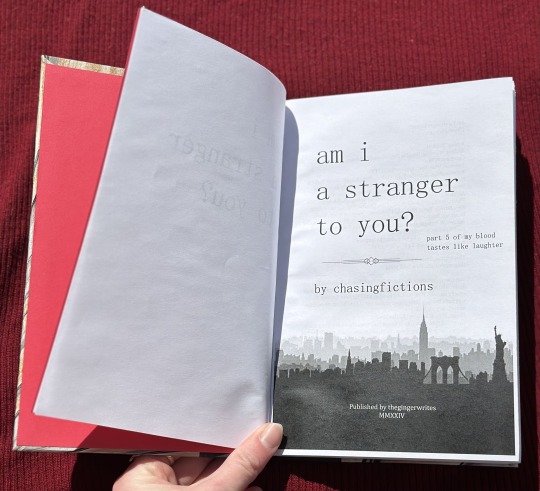



Summary:
Just then, the last of the blood slipping from that boy into Spike, him and Dru grabbing for each other with their fangs in each other’s mouths, then walking hand in hand up Fifth Avenue, all the way back home, a little prayer croaks out of him, before he realizes enough to grab it back—
Please. Please, let it be like this always.
-
(In which New York City is one of the various loves of Spike's unlife, he can’t stop thinking about the Slayer, and in which, mostly, he just really wants to belong somewhere, if anyone will have him.)
link here
I was inspired by the folks at the Renegade Bookbinding Guild and their Binderary 2024 events to try my hand at binding some of my favorite works of fanfiction. This one is the fifth part of chasingfictions my blood tastes like laughter series and has had a special place in my heart since 2021. I'm from NY and I read this between classes my first semester back at school during the pandemic and Spike's love for the city seemed to perfectly resonated with my own so I wanted to commemorate that in print!
This is the first text block I've ever sewn by hand. At four signatures, this seemed like a perfect starter project. I'm learning that part of designing books is doing it by ✨vibe✨ The gray/white/silver/gold marbled cover said New York to me, sort of a glass and concrete with a bit of shine aesthetic. I went with red end papers because vampires. The typesetting isn't too fancy but I really wanted to find an art deco ornament to separate sections of the fic. It took me a while to figure out how I wanted to decorate the spine. I originally used a gold foil quill to trace the text of the title and author but then went over it with a paint pen recommended in one of the Binderary sessions last month and fell in love with the effect. I can't believe my hand was steady enough to get it that clean 😅
#fanbinding#binderary2024#spuffy#spikedru#btvs#chasingfictions#me at the end of february: these projects are such a great lesson in not letting perfection get in the way of good/done#me weeks later still not having taken the pictures: maybe i haven't learned that lesson just yet
82 notes
·
View notes
Text
Fandom Trumps Hate 2024!

Looking for a scene drawn for your story? A piece to help inspire you to write a fic? A new icon? How about covers for your story with full print-ready Graphic Design service? Maybe a pinup, or some trading cards (up to 10)?? Maybe a gift for someone, or just your vision of a character(s) (up to 3 character sheets) for your AU?
Well, that’s just some of the stuff I’m willing to offer for this year’s @fandomtrumpshate Charity Event! FTH is a WONDERFUL community project that supports amazing non-profits through donations for fanworks via this wonderful annual event!
I am participating for my fifth year by offering 2 fanarts for y’all in either the BBC Sherlock or Good Omens fandoms, starting at 20$ for the non-profit of your choice!
Here are some past FTH pieces I’ve done, if you’re interested in seeing the scope of the work you would be getting from me:
2020:
GO - :FTH 2020 – Lagniappe for Big_Edies_Sun_Hat:
GO - :FTH 2020 BONUS – Réveillon for Big_Edies_Sun_Hat:
2021
SH - :This Year: (FTH #1 for @discordantwords)
SH - :Burlesque Johnlock: (FTH #2 for @ohlooktheresabee)
2022
SH – :A Quiet Moment: (FTH #1 for @totallysilvergirl)
SH – :Against the Wall: (FTH #2 for @anarfea)
2023
SH – :Let Me Come to You: (FTH #1 for ShakespearelovedLadyMacbeth)
SH – :Couch Cuddle: (FTH #2 for @discordantwords)
SH – :More Every Minute: (FTH #3 for @totallysilvergirl)
And of course, you can browse all my art to see my range:
@stephdrawsjohnlock
stephdrawsfanart on Instagram
@stephratte (Primary Multifandom Art Blog)
stephratte on deviantART
I will draw any ship from any of the above fandoms. All my work is done as a hi-res 3000x3000 print-ready piece in Procreate. Traditional media (markers, India ink, and pencils) is also available if you prefer, done on illustration or marker paper at the paper’s size, with the option of acquiring the original if you choose. I will also do it at a requested size if you have a preferred format for something specific (like a book cover or a comic panel). Feel free to DM me if you have any questions.
The browsing begins on Feb. 26, and the bidding opens on March 1! I hope I once again get a chance to do a couple fantastic pieces for y’all!! I love doing this so much, so keep an eye out for my info post soon once it’s official!
122 notes
·
View notes
Note
Rq who is nika? Had some art tagged daminika cross my dash and I am Intrigued
Nika alias Flatline, a character created by writer Joshua Williamson and artist Gleb Melnikov, was introduced in Robin(2021) run—where Damian Wayne as the fifth Robin running off home attended the Death tournament on Lazarus Island.
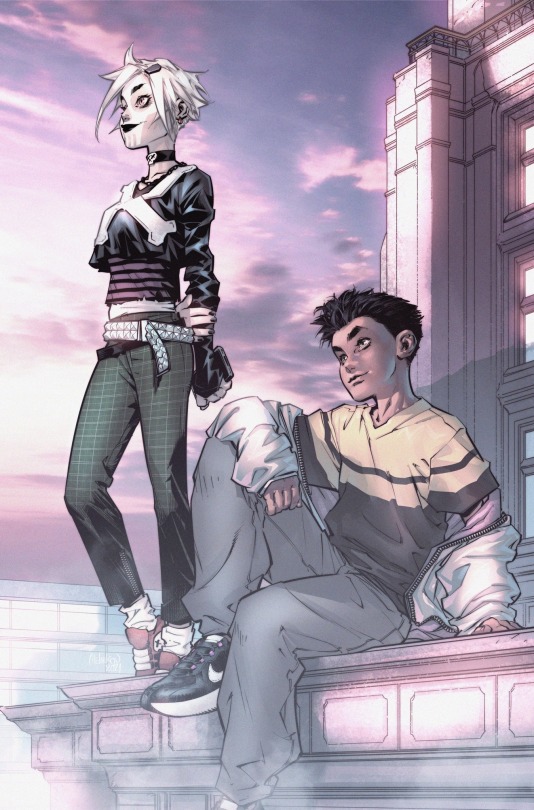
Nika is the first opponent Damian faces on the island and she proceeds to take his first life with her signature move— ripping his heart out with her bare hand (no one actually dies, people would have three lives during the tournament on the island).

She is a Russian metahuman girl and a martial arts fighter, with the power to absorb the skills of people who had died in her hands.

Flatline(+Damian) arts from Gleb Melnikov's Twitter(X)
Here's the reading guide/list of her! Made by @/ redhoodtwt on Twitter(X)
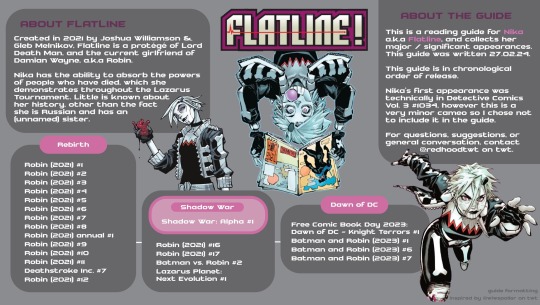
Reading order↓ (text ver.)— Mainly appears in Robin(2021), Lazarus planet: Next evolution, and Batman and Robin(2023), with some mentions and cameos in other/different issues
Rebirth- Robin(2021)#1-8, Robin(2021)Annual#1, Robin(2021)#9~11, Deathstroke Ink.#7, Robin(2021)#12
Shadow War- Shadow War: Alpha #1, Robin(2021)#16~17, Batman vs. Robin#2, Lazarus planet: Next evolution#1
Dawn of Dc- Free comic book day 2023: Dawn of dc- Knight Terrors#1, Batman and Robin(2023)#1, Batman and Robin(2023)#6~7…(current ongoing run)
Another Flatline summary and reading list made by @/ batquinz on Twitter(X)
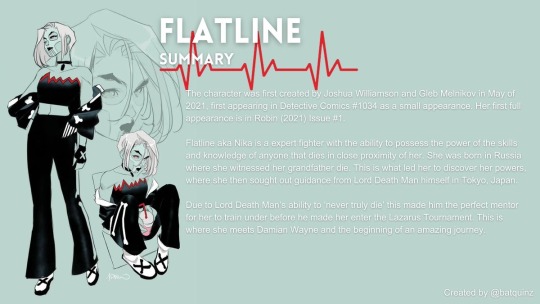
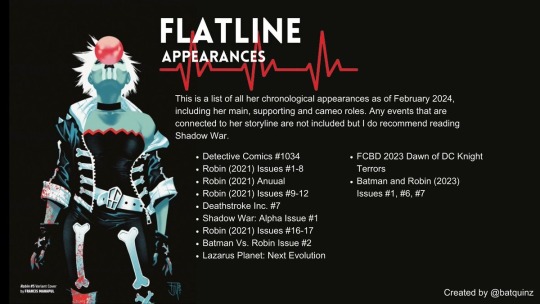
And here's a quick rundown of Nika and Damian's relationship thread on Twitter(X) Made by @/ nightwingstyles

Some daminika covers that I love! (they have a lot of ship names, and the most popular ones are: daminika, flamian, gravebird🪦🕊️, graverobin🪦🐦, birdskull🐦💀)



Cover art- Robin(2021)#2/ #7/ #15(1:25 variant cover)- Artist: Gleb Melnikov/ Simone Di Meo/ Mario Foccillo
And currently, Nika is in the new issue of Batman and Robin(2023)# 7!
Thank you for reading and taking an interest in Nika!! Hope you will like her as an amazing cool character!!!💀♥️
#nika#flatline#damian wayne#robin 2021#batman and robin 2023#nika dc#flatline dc#damian al ghul#daminika#flamian#gravebird#graverobin#birdskull#character guide#flatline guide#nika guide#flatline reading guide#nika reading guide#comic reading list#dc comics
95 notes
·
View notes
Text
Tenshō Daijin: the many guises of medieval Amaterasu (part 1)

I’ve been working on this article on and off since late 2021, and it’s the longest one I’ve published on my blog so far (some of my wikipedia contributions are bigger, but that’s a separate matter). In fact, it's so long I have to split it into two due to limitations of tumblr's post editor.
When most people speak of “Japanese mythology”, 99% of the time they effectively think just of the Kojiki and Nihon Shoki (with some night parade scrolls sprinkled in, maybe, even though that’s not really mythology, but Edo period popular entertainment). The goal of this article is to challenge this incorrect view, and to shed some light on the mythology of the Japanese “middle ages” - roughly between the 11th and the 16th centuries.
I decided to use Amaterasu as the main topic, as it’s hard to think of a better way to showcase how much mythology remains outside the general perception than using a figure who, at least at first glance, is well known as an example. From Brahma longing for a friend to Yang Guifei surviving own death, I’m sure everyone will find something new here.
Myths obviously aren’t all that will be covered here, though. I’ll also discuss the theological doctrines which flourished in the middle ages, with a particular emphasis on honji suijaku, their social context, and more. You will be able to find out what rituals focused on Amaterasu had to do with Enma and Taizan Fukun, how economic woes of the Outer Shrine of Ise impacted Brahma’s role in Japan, why some secrets existed only to be deliberately revealed, and more.
Kami and Buddhism
In order to discuss the development of Amaterasu’s character and her associations with other figures through the middle ages, as well as the myths which developed as a result, I’ll first need to summarize the nature of interactions between kami and Buddhism through the Nara, Heian and medieval periods. I’m specifically saying kami, as opposed to Shinto, for reasons which will become clear later.
It seems that at first the relation was rather standard as far as early interactions between Buddhism and preexisting religious traditions in areas where it was introduced go. Mark Teeuwen singles out Tibet and various kingdoms corresponding to parts of present day Myanmar as examples particularly similar, though obviously not identical, to early Japan. The parallel developments concerned the Bön faith in the former and the beliefs pertaining to the nat in the latter.
The early sources appear to indicate that kami were envisioned as beings who need to strive towards enlightenment themselves. Recitation of sutras was described as a way to bring them closer to that state. However, some rather quickly started to be viewed as active protectors of Buddhism. As early as 741 Hachiman was already regarded as such, for instance. Additionally, combinative “shrine-temples” already existed in the same period too, attesting to a fusion of Buddhism and preexisting tradition.
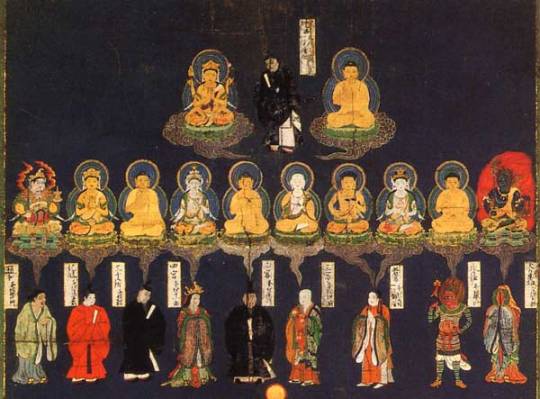
A schematic representation of some examples of the honji suijaku from the Kasuga mandala (wikimedia commons)
A breakthrough occurred in the ninth century, with the development of honji suijaku (本地垂迹) - the theory on kami being “traces” or “emanations” (suijaku) of Buddhist figures, referred to as “original sources” (honji). Similar theories regarding Daoist figures were at times advanced by Chinese Buddhist scholars as early as in the fifth century, so it was hardly an unparalleled development, though its scope was fairly unique. By the end of the Heian period, honji suijaku became the default mode of understanding kami.
A common misunderstanding today is that honji suijaku meant exact correspondence between a single Buddha and a single kami. In reality, what it created is a “fluid pantheon”, to borrow the title of one of Bernard Faure’s books dealing with this phenomenon. Connections between specific kami and Buddhas (or bodhisattvas) certainly were often established. However, that was not all.
Kami could be connected to other kami, and Buddhas to other Buddhas; and on top of that both groups belonged to an elaborate network which also included devas, wisdom kings, astral deities, legendary heroes and historical figures from various countries (for example Daoist immortals), and beings which defy classification altogether. In Keiran Shūyōshū (溪嵐拾葉集), the notion of honji suijaku is even extended to silkworms (their honji is Aśvaghoṣa). Multiple identifications could coexist, sometimes in the same sources. On top of that, individual figures could change classification depending on context.
The new theological ideas also lead to the formation of new myths, collectively referred to as chūsei shinwa (中世神話; “medieval mythology”). As summarized by Sujung Kim, this term encompasses both the myths which arose in the Japanese “middle ages”, the Kamakura and Muromachi periods (1185-1600), and modern study of them. A closely related, though more narrow, term is chūsei nihongi (中世日本紀), which refers specifically to reinterpretations of preexisting classical myths, for example Nihon Shoki, from the same times.
One of the primary goals of the new myths was to create a metaphorical bridge between Japan and the lands described in Buddhist literature transmitted from China, Korea and beyond. Sutras and other literature were often set in fabulous distant kingdoms or in supernatural realms. At the same time, the material reality of Buddhism tied it to local institutions and landscape. As a result, the local was imbued with a new, universal meaning.
As Mark Teeuwen put it in his article The Buddhist Roots of Japanese Nativism, medieval literature “allowed a local warlord to pose as a golden cakravartin, a local mountain to take on the guise of the cosmic Mt. Sumeru, a local deity to embody an aspect of the World Buddha, and a local rite to aspire to the universal aim of bringing salvation to all sentient beings.” At the same time, the universal gained a local dimension, making it easier to grasp and more approachable.
However, that was hardly the end, more like the beginning - yet another prominent change which occurred over the course of the 12th and 13th centuries resulted in the formation of a new belief: select kami were in fact not emanations of secondary importance of Buddhist figures, but direct representations of enlightenment. These developments eventually culminated in what is sometimes described as “reverse honji suijaku”: Buddhas and bodhisattvas were merely manifestations of primordial kami, not the other way around.
The motivations behind the development of these ideas are not clear. While especially in the past it was commonly assumed that they represented the beginning of a “pristinely Japanese” spirituality reasserting itself against “foreign” Buddhism, most of the theologians involved were Buddhists themselves, or at least enthusiastically drew inspiration from Buddhist sources. Mark Teeuwen and Fabio Rambelli suggest they might have been motivated by a desire to take Buddhist theology to logical extremes in order to investigate the nature of reality before the emergence of the first Buddha and the current kalpa.
Furthermore, in addition to lofty theological speculation material motivations might have been at play. Many of the advocates of reverse honji suijaku might have been so-called “shrine monks”, tasked with maintaining the shrine parts of religious complexes. Possibly their need for broader recognition and greater authority made them keen on such theological reversals. This is ultimately speculative, though.
Curiously, reverse honji suijaku arguably might have led to the creation of Shinto in the modern sense. While the phrase 神道 has a long history, and it is applied to intellectual and religious movements active in the middle ages in modern literature (for example, the treatises of a certain priestly family I’ll discuss are often called “Watarai Shinto”), there is no strong evidence that it was commonly understood as shintō in the modern sense - a distinct religious tradition - predating an explicit statement in a treatise from 1419 written by the Tendai monk Rysōhen dealing with these topics. In the earliest sources the default reading was jindō, referring not exactly to a distinct system of beliefs, but rather to a “realm”of kami ultimately existing in Buddhist context. While Shinto did eventually develop into the tradition which came to define the kami, through the middle ages and the Edo period which followed, honji suijaku was the dominant paradigm, and permeated all spheres of society.
The early history of Amaterasu: sun, textiles and longing for companionship
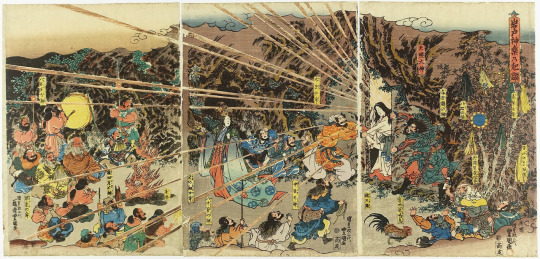
An Edo period painting of Amaterasu emerging from the cave, by Kunisada Utagawa (wikimedia commons)
While the explanation of the basic nomenclature and a crash course in interactions between Buddhism and kami is now out of the way, before I’ll be able to move on to the impact of the medieval ideas on Amaterasu I need to briefly summarize her earlier history.
Through the article I will simply use the name Amaterasu consistently. However, it should be noted that the standard form of the name, 天照大神, in the middle ages and in the Edo period was often read not as Amaterasu Ōkami, but rather as Tenshō Daijin, in accordance with on’yomi or “Sino-Japanese” sign values. Therefore, don’t be surprised that this is the version used in titles of historical works mentioned. As a curiosity it is worth mentioning that this is actually the reading used fairly consistently in the first western source with reasonably reliable information about Amaterasu (unless I missed something even earlier), Engelbert Kaempfer's History of Japan from 1727.
On a similar note, I generally stick to describing Amaterasu as female. However, it needs to be pointed out that through the middle ages and in the Edo period male Amaterasu is also attested, depending on the source either replacing the female version or coexisting with her. Some modern authors go as far as speculating if Amaterasu wasn’t originally seen as male prior to being redefined as female, but this is not really fully provable.
The existence of a tradition according to which Amaterasu manifested in male form is already mentioned by the Tendai monk Jien (1155-1225). There are also sources providing ambiguous information about Amaterasu’s gender. In at least some cases such phenomena were a result of identification with figures either regarded as male or portrayed as androgynous in art, as I outlined in a recent article discussing the case of Amaterasu and Uho Dōji (who won’t be brought up here in any meaningful capacity, since I'm not going to focus on the Edo period). It’s not really possible to make a blanket statement on this matter, though.
Additionally it’s important to bear in mind that identification between two figures could transcend the gender of the parties involved. As you’ll see later, there were even cases of Amaterasu’s identification with a male figure actually resulting in traditions particularly strongly emphasizing her typical gender.

The Inner Shrine at Ise in 2008 (wikimedia commons)
Throughout her entire history Amaterasu has been associated with Ise and its Grand Shrine. According to the Nihon Shoki, that’s where she originally descended from heaven to earth, and where she later returned in order to be enshrined. The term “Ise Grand Shrine” actually refers to a complex centered on two major shrines, though, and only one of them, the Inner Shrine (内宮, naikū), is dedicated to Amaterasu. The kami of the Outer Shrine (外宮, gekū) is instead Toyouke.
The earliest history of Amaterasu is effectively unknowable due to lack of available sources. While she does appear both in the Kojiki and Nihon Shoki in a central role, both of these works only date to the eighth century, and their historicity is often at best dubious. When exactly was her shrine originally established is a matter of debate: supporters of treating Nihon Shoki literally argue for 4 BCE (during the reign of the legendary emperor Suinin), but historians and archeologists favor more vague dating to either the fourth, fifth or seventh century. The earliest detailed records of specific religious ceremonies at Ise can only be found in an administrative protocol compiled in 804.
Historically it was quite popular among researchers to essentially assume being a personification of the sun is all there ever was to Amaterasu’s character, and that she derives her importance entirely from her solar role. Today this view is no longer accepted quite as firmly, and it is even sometimes questioned if this was necessarily her original function, though this is ultimately neither entirely provable nor fully relevant here.
Obviously, the classical Amaterasu also served as a royal deity presented as an ancestor of Japan’s imperial lineage. She was also treated as a symbolic source of its authority by extension of her role as a heavenly ruler commanding the kami. This is an example of the well documented phenomenon of clan kami (氏神, ujigami). However, based on archeological data Ise was not particularly important early on in Japanese history, and the area around it was sparsely populated as late as in the seventh century On top of that it would appear that, if the early texts are to be believed, emperors actually had an ambivalent relationship with her. It has been suggested that her classical position was only established during the reign of emperor Tenmu in the late seventh century, perhaps due to his personal connection to clans from the Ise area.
It’s important to stress here that on multiple occasions in history, in particular recent history, the connection between Amaterasu and emperors was channeled to nationalist and imperialist purposes. For instance, the Japanese colonial government in Korea funded the construction of a complex enshrining Amaterasu and emperor Meiji in the 1920s, and subsequently legally obliged students (among others) to attend ceremonies held there to foster loyalty.

The Outer Shrine in 2015 (wikimedia commons)
A key moment in the early history of Amaterasu was the introduction of the kami Toyouke (豊宇; literally “abundant food”) to Ise. A legend about her arrival is preserved in the aforementioned administrative protocol from 804. According to it, Amaterasu appeared to emperor Yūryaku (second half of the fifth century, if his historicity is to be accepted) in a dream to let him know that she is distressed and lonely, and on top of that can’t receive offerings of food according to proper protocol. She explained that the only way to solve all of these problems is to bring her a kami responsible for divine food (御饌津神, miketsu kami), Toyouke, who is to be found in Hiji no Manai in the Tanba Province. Thanks to this precise guidance, the emperor was able to instantly solve the problem, and Toyouke was moved to Ise, where she symbolically took the responsibility for food offered to Amaterasu.
Presumably, the legend contains at least a kernel of truth, and Toyouke was initially enshrined in a facility meant to fulfill a specific ritual role for the Inner Shrine, which in time grew to rival it in size and importance. Save for these details, much about the early history of Toyouke is even more unclear than in the case of Amaterasu, though. She is only mentioned in passing in the Kojiki under the name Toyoukehime no Kami (豊受姫神) in the account of the birth of Wakumusubi no Kami (和久産巣日神), one of the many kami who came into being as a result of Izanami’s death. However, this passage does not provide any information about her character, it merely states that she is Wakumusubi’s child. This tradition was of limited, if any, interest to the Outer Shrine clergy through the middle ages, as I’ll later demonstrate.
While Wakumusubi also appears in the Nihon Shoki, though with a slightly different genealogy, Toyouke is entirely absent from this work. You can find a claim on the contrary in Michael Como’s Weaving and Binding. Immigrant Gods and Female Immortals in Ancient Japan, but he essentially treats Ukemochi as identical with Toyouke and asserts the myth about Tsukuyomi killing the former is effectively about the latter. It doesn’t seem like any subsequent publications picked up this idea.
The final early source of information about Toyouke is the Tango no Kuni Fudoki (丹後国風土記; “Records of the Tango Province”). It presents her as one of eight “heavenly women” (天津乙女, amatsuotome) who at some point arrived at a spring near Mount Hiji to bathe. An old couple stole the clothes of one of them, rendering her unable to return to heaven. They subsequently ask her to become their daughter, since they have no children. She agrees, and for ten years lives with them, brewing sake which could magically heal “ten thousand ills”. The old man and woman prosper thanks to her. However, they eventually decide to tell her that she is not really their child, and should go back to heaven. She tells them that she has lived among humans for so long this is not an option for her anymore, and leaves in anger. She only calms down after reaching a different village, Nagu, where she is eventually enshrined under the variant name Toyoukanome no Mikoto (豊宇賀能売命).
Due to involving a heavenly being having to stay on earth due to her clothes being stolen, this myth has been compared to the better known Hagoromo. Michael Como also argues that it might reflect the perception of Toyouke as a Daoist immortal (hence her ability to bew something akin to the fabled Daoist alchemical elixirs meant to prolong life), similarly to how the legend of Urashima Taro does. While I found his Nihon Shoki argument somewhat dubious as I said, I think this is an interesting point which warrants further study. Similar possibility about Toyouke’s character has been suggested by Bernard Faure too.
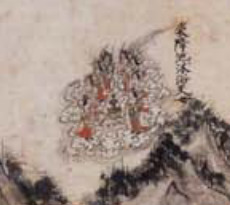
It’s also worth noting a possible reference to the Tango no Kuni Fudoki myth has been identified in a painting of the two shrines of Ise from the collection of Shōryakuji, a Buddhist temple located in Nara (seen above; screencapped from Talia J. Andrei's Mapping Sacred Spaces: Representations of Pleasure and Worship in Sankei Mandara, for educational purposes only). It depicts eight female figures standing on a cloud around a container used to make sake in the proximity of the Outer Shrine.
Amaterasu and Buddhism: the ambivalent beginnings
Early sources pertaining to Ise discussed in the previous section are invaluable when it comes to Amaterasu’s position and her connection with Toyouke, but they don’t really shed any light on the development of associations between her and Buddhist figures. Quite the opposite - they indicate that around the year 800, even basic Buddhist terms like “pagoda”, “monk” or “sutra” were considered taboo (忌み, imi) by priests of the Inner Shrine, much like these pertaining to conventional sources of religious impurity like violence, death or illness. However, Mark Teeuwen notes at the same time these very priests most likely took part in Buddhist ceremonies themselves, and there is even some evidence that in the eighth century a Buddhist temple existed in Ise.
The reasons behind the implementation of the taboo were likely largely political, rather than strictly religious. For context: in the second half of the eighth century, empress Shōtoku famously appointed Buddhist monks to various prestigious positions in the royal court. Dōkyō from the Hossō school was even temporarily elevated basically to the rank of her equal (though he eventually fell from grace). This was generally poorly received by other officials, who might have viewed it as an attempt at establishing Buddhist theocracy in place of hereditary monarchy. This in turn likely led to tensions and fueled various succession controversies in subsequent decades. Further problems, like untimely deaths or exile of various members of the imperial family, kept accumulating, and by 804 the prestige of the court was severely damaged. Furthermore, there is evidence that there were various economic conflicts of interest between the Ise clergy and local Buddhist monks.
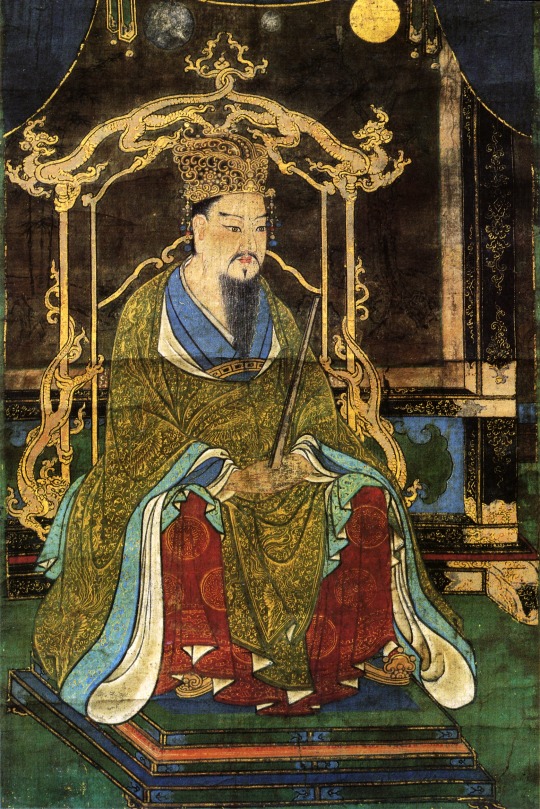
A sixteenth century painting of emperor Kanmu (wikimedia commons)
Since the oldest source to mention the taboo is an administrative, rather than religious, text, it is not impossible that it was intended by emperor Kanmu as a way to diffuse all these social and political tensions. Mark Teeuwen suggests his goal might have been a way to restore the prestige of his family and create a center of symbolic ancestral cult which would offer him additional legitimacy independent from the Buddhist establishment residing in Nara, which was crucial for many of the previous emperors. As a lifelong student of Confucian philosophy, he likely found many models to draw from in Chinese texts. His vision of Ise was presumably that of an ancestral mausoleum.
Regardless of Kanmu’s decisions, in the long run Buddhism retained its influence in royal affairs. In fact, it was arguably this emperor himself who indirectly caused its revitalization. In 804, he sent two young monks, Saichō and Kūkai, to China. They returned with something previously largely unknown in Japan: esoteric Buddhism. The new schools they established, Tendai and Shingon, captivated the imagination of virtually all strata of society in the nascent middle ages.
Amaterasu, too, came under esoteric Buddhist influence, and gained new roles, often completely detached from her earlier character - or at the very least from the part of it firmly tied just to the ruling family. Mark Teeuwen partially jokingly refers to this chapter in her history as an “escape” from Ise and notes that for a time she has “shaken off the imperial shackles”.
There was a material aspect to these processes in addition to the purely theological considerations. In the Kamakura period, the role of warrior classes grew and the imperial court weakened. As a result, the Ise clergy - the Arakida clan of the Inner Shrine and the Watarai clan of the Outer Shrine - gained greater autonomy. The emperors weren’t able to enforce a symbolic monopoly on Ise, which therefore no longer served just as a center of ancestral cult. The downside was the loss of most of the imperial funding, which necessitated innovation to secure other sources of patronage.
The Ise taboos established earlier were not exactly abandoned, but the clergy found ways around them in order to enable Amaterasu to thrive in this new environment. A summary of the theological solution they developed is provided in Nakatomi Harae Kunge (中臣祓訓解; “Reading and Explanation of the Nakatomi Purification Formula) from the late twelfth century: “although on the surface performing ceremonies which are different from the Buddhist teachings, [Amaterasu] in essence protects the Buddhist laws.” Additionally, a myth reinterpreting one of the most famous episodes from the entire Buddhist canon, but with Amaterasu as a new protagonist, was developed to justify the taboo’s existence. I’ll discuss it in a separate section later on.
The reinvention was evidently successful. There is little evidence for widespread worship of Amaterasu in earlier periods. She was effectively little more than a royal deity. Even courtiers had limited, if any, knowledge of her. Only in the middle ages did she come to be widely recognized as a major figure in the Japanese religious landscape among all strata of society. Paradoxically it was the partial detachment from the imperial family that let Amaterasu claim a uniquely elevated position in the pantheon.
One of the best sources of evidence of Amaterasu’s newfound popularity are standardized oath formulas (起請文, kishōmon). In the Kamakura period, she came to appear in them quite frequently. She was invoked either simply as the foremost kami, or alternatively as the “lord of the land” (ie. Japan; 国主, kokushu). Either way, her purpose, much like those of other of the invoked figures, was to guarantee the oath will be upheld, and to punish those who will break it.
The spread of Amaterasu to new audiences resulted in the rise of numerous new interpretations. That’s where the already briefly discussed idea of honji suijaku came into play.
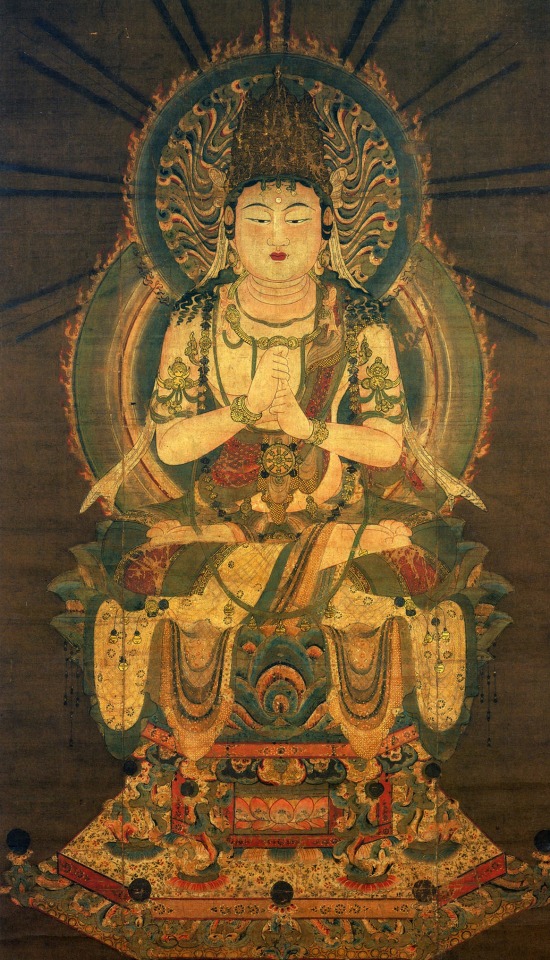
A twelfth century painting of the Buddha Dainichi (wikimedia commons)
As I said earlier, despite the popular understanding of this term honji suijaku did not necessarily just signify correspondences between kami and buddhas. However, in Amaterasu’s case the earliest example actually does match this model. She came to be associated with the Buddha Dainichi (大日, literally “great sun”; from Sanskrit Vairocana).
Some authors, like Bernard Faure, argue that the establishment of a link between Amaterasu and Dainichi was effectively the core of the early honji suijaku as a whole. Purportedly the belief that a connection existed between them went all the way back to the teachings of the famous monk Gyōki, active in the first half of the eighth century. The historicity of this claim is uncertain, but it was understood as historical truth in the discussed time periods, at the very least. Anna Andreeva, relying on earlier studies by Satoshi Itō, notes that it would appear Seizon’s (成尊; 1012–1074) Shingon Fuhō San'yōshō (眞言付法纂要抄; “An Abbreviated Compendium of the Transmission of Shingon Buddhism) from 1060 has a strong claim to being the oldest attested example which can be properly dated.
While other Buddhas, such as the historical Buddha, Amida (Amitābha), Miroku (Maitreya) or Yakushi (Bhaiṣajyaguru), are obviously also present in Japanese Buddhism, historically, especially prior to the rise of Amida-centrist schools, Dainichi was by far the most important one. This is especially pronounced in Shingon, where he is recognized as the “first Buddha” (Ādi-Buddha). Dainichi’s importance coupled with his solar associations made him a suitable match for Amaterasu in the eyes of theologians.
Amaterasu’s solar role is pretty widely acknowledged in Buddhist sources, and she could be labeled as a “solar deity”, nisshin (日神). She was also identified with Nittenshi (日天子), the Buddhist version of the Hindu sun god Surya. However, Nittenshi could also function as a distinct figure and had his own iconography.
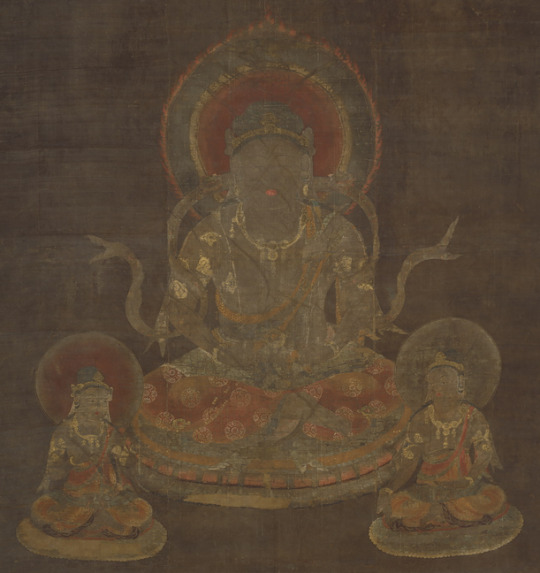
A twelfth century hanging scroll showing Nittenshi in the company of attendants (Kyoto National Museum; reproduced here for educational purposes only)
The development of a connection between Amaterasu and Dainichi brought a number of changes to Ise. As an extension of it, the Inner Shrine and Outer Shrine at Ise came to be identified with the Womb Realm mandala and the Diamond Realm mandala, closely associated with him.
The Ise clergy additionally argued that the taboo observed as the shrines does not impact Amaterasu’s connection to Dainichi - rather she (and by extension Toyouke as well) represents not a mere trace of this Buddha, but “original enlightenment” (hongaku). A new systematization of kami was built around the idea: at Ise, only Amaterasu and Toyouke were regarded as belonging to the category of “kami of original enlightenment”, with other divided into “kami of inception of enlightenment” (those who had to actively embrace Buddhism) and “kami of delusion” (those who opposed it). Similar categories were employed in different areas too, though, with the head local kami, for example Suwa Daimyōjin or Sannō (山王), taking the same role as Amaterasu at Ise.
While Dainichi can be considered Amaterasu’s essential honji suijaku pair, I already pointed out, it was hardly unusual for a specific figure to develop multiple connections within the honji suijaku framework, though, and this holds true for her too.
Amaterasu, Enma and other functionaries of the underworld
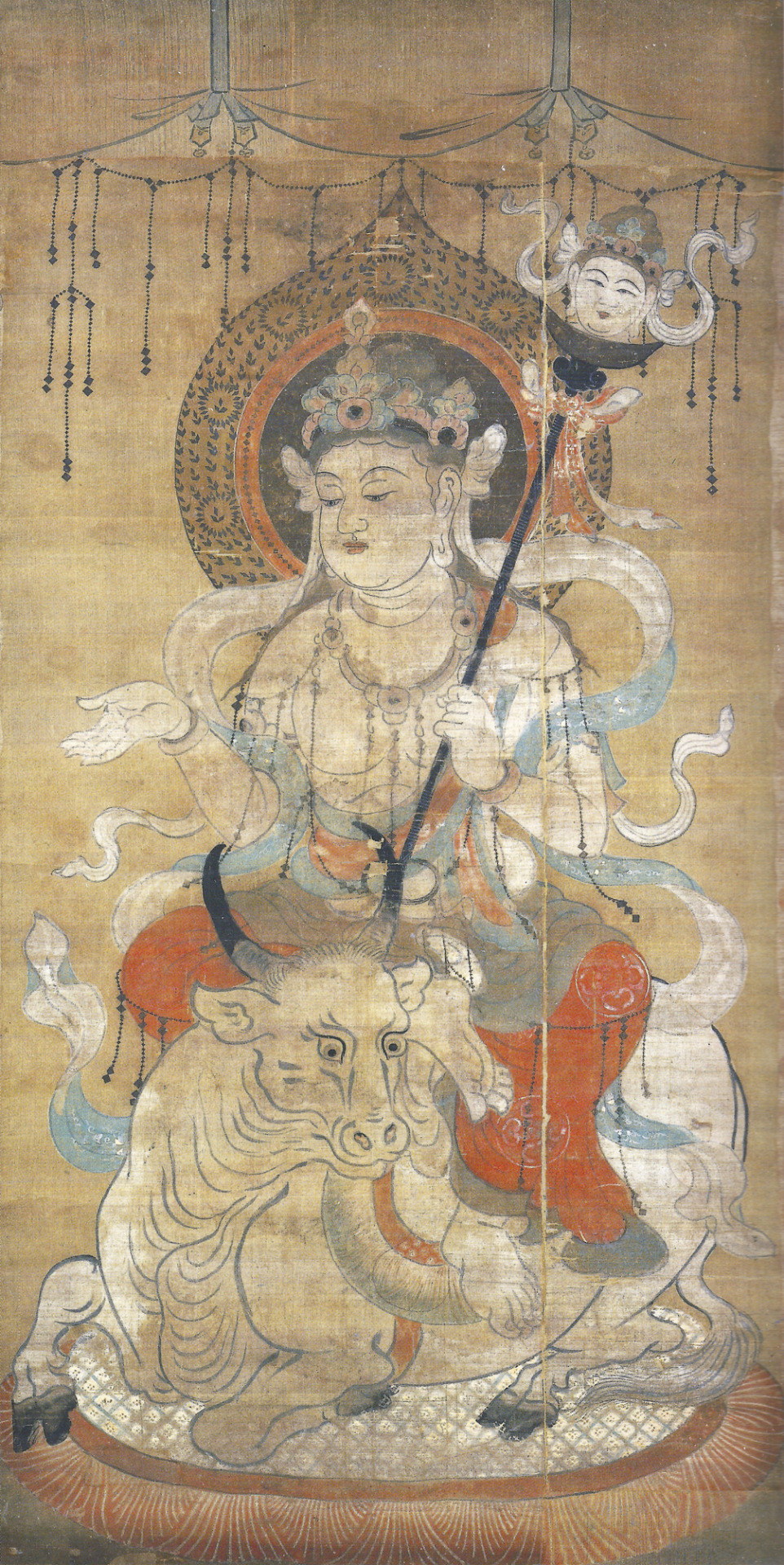
Enmaten (wikimedia commons)
Next to Dainichi, Amaterasu’s best attested Buddhist “counterpart” is not a Buddha, but rather a deva, specifically Enma, the judge of the dead. While many other devas present in Japanese Buddhism largely languish in obscurity today, at least in popular perception, he is probably the most recognizable one next to the Four Heavenly Kings, so I do not think much of an introduction is needed. Even if you are not particularly interested in the history of religions, chances are you’ve seen him in one piece of media or another.
Technically there are two distinct forms of Enma in Japanese tradition - Enmaten (焔摩天), who is more of a “classical” Hindu-style deva fairly similar in appearance to the original Yama, and the more popular Enma-ō (閻魔王; “king Enma”), styled after the bureaucratic Chinese underworld deities - but this distinction is not very important here. His rise to prominence in Japan started in the early ninth century at the latest, and by the ten century he was also joined by Taizan Fukun (東岳大帝; originally Taishan Fujun), a similar deity incorporated into Buddhism from Daoism. The latter was essentially the model for all of the other judges of the underworld: from the Buddhist kings of hell, to various local gods who took this role in the popular religion of Qing China. He might have even influenced the development of Matarajin in medieval Japan, but that’s a topic for another time.
It seems that a link between Amaterasu and Enma was initially established through an intermediary, specifically Seoritsuhime (瀬織津姫). She is identified with the king of hell in the Nakatomi Harae Kunge. While much about this text remains a mystery, in this case the logic behind the equation is quite clear - both of them were invoked during ritual purification. The means were not quite the same: Enma throws the sources of impurity into the deepest hells, while Seoritsuhime casts them into the ocean. Still, the level of similarity was sufficient to warrant establishing a connection.
Seoritsuhime is described both as a servant of Amaterasu, and as her aramitama (荒魂), literally “rough spirit”. This term designates the wrathful, or at least impulsive, aspect of a given kami. In Nakatomi Harae Kunge Seoritsuhime as a manifestation of Amaterasu is also more specifically described as ara-tenshi (荒天子), “heavenly emperor manipulating the brutish force”.
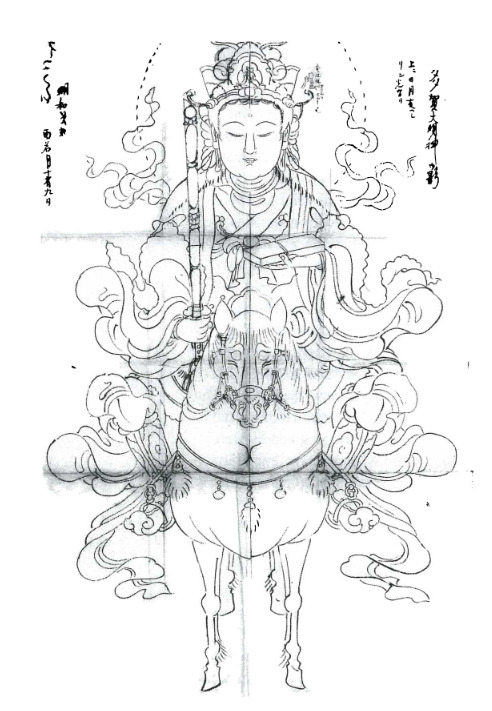
An Edo period depiction of Taga Myōjin from the collection of Kyoto City University of Arts (via Bernard Faure's Fluid Pantheon; reproduced here for educational purposes only)
Tenshō Daijin Kuketsu (天照大神口決; “Oral Transmission Pertaining to Tenshō Daijin”), a fourteenth century theological treatise, also embraces the equation between Enma and Amaterasu. It explains that he corresponds to the form of Amaterasu associated with the Taga shrine, Taga Myōjin (多賀明神). She has a distinct iconography, and fairly consistently appears as a horsewoman on either a black or white steed (always shown frontally), with a sword in one hand and a box with a sutra in the other.
The same source also equates Amaterasu with Godō Daishin (五道大神; originally Wudao Dashen), the “god of the five paths”, another king of hell. In the Nakatomi Harae Kunge, it is instead a purifying kami, Haya-Akitsuhime (速秋津比売神), “the beloved of the dragon king Nanda”, who corresponds to him, though. The passage establishing this also mentions a similar link between yet another purifying kami, Ibukidonushi, and Taizan Fukun (curiously, the explanatory line states that the river where Izanagi purified himself after fleeing from Izanami is identical with Mt. Tai, the residence of Taizan Fukun). However, the latter is also said to be the aramitama of Toyouke.

A Japanese statue of Baozhi (Kyoto National Museum; reproduced here for educational purposes only)
Tenshō Daijin Giki (天照大神儀軌; “A ritual manual [for the worship] of Tenshō Daijin”) states that Amaterasu as a judge of the dead commands eleven messengers referred to as “princes”. It’s not easy to date this text precisely, though it’s clear it was already in circulation by 1164. It claims to contain knowledge originally revealed to the legendary Chinese monk Baozhi (寶誌; 418-524), best known from a legend commonly referenced in art in which he tears his face apart to reveal the visage of bodhisattva. The text effectively redefines Ise itself as a place where the underworld officials gather, imbuing the temple complex with new meaning, detached from its older role as a center of royal ancestor cult.
The eleven messengers listed are Zuikō Tenshi (a manifestation of Enma), Ryūgū Tenshi (dragon king Nanda), Suijin Tenshi (dragon king Batsunanda), Tenkan (“magistrate of heaven”), Chikan (“magistrate of earth”), Shimei (an underworld official), Inin Tenshi (equated with Izanagi and with Shiroku, an underworld official paired with Shimei in other sources), Kōzan Tenshi (Taizan Fukun), Godō Daishin, Kazenagashi no Kami and Okitama (a water deity equated with Suikan, “magistrate of water”). They correspond to various auxiliary shrines at Ise. Each of them is said to command a retinue of “four thousand trillion spirits”. While abstractly big entourages are quite common in medieval sources, from Michizane’s 105000 thunder god subordinates to Tenkeisei’s 84000 shikigami, even by these standards the number is unusually high.

The Enmaten mandala, with Taizan Fukun (middle of the top row) and Shimei, Godo Daishin and Shiroku (bottom row) shown among his attendants (wikimedia commons)
The lists of underworld officials serving Amaterasu show a considerable degree of overlap with these present in ritual texts Enmaten Ku (閻魔天供) and Taizan Fukun no Sai (泰山府君祭; you may know it from the story of Tamamo no Mae). Notably, Tenkan, Chikan, Suikan, Shimei and Shiroku are all members of Enma’s entourage in origin. The last two are scribes responsible for keeping track of human lifespans, but the role of the former three is not well understood.
Another deity present both in these rituals and in Amaterasu’s entourage, Godo Daishin, is a king of hell in his own right. His origin is unclear, though the oldest sources which mention him are Chinese apocryphal episodes from hagiographies of the historical Buddha. As the “god of the five paths”, he is responsible for assigning the dead to one of the five realms of rebirth: these of gods, humans, animals, hungry ghosts or hell. Notably missing is the asura realm, which didn’t particularly catch on in East Asian Buddhism. In the oldest sources, he is portrayed as somewhat inept and after meeting the Buddha implores him to teach him how to fulfill his role better.
Enmaten Ku and Taizan Fukun no Sai attained a considerable degree of popularity in the eleventh and twelfth centuries due to the spread of the bureaucratic image of hell, and many laymen sought Buddhist monks (in the case of the former ritual) and onmyōji (in the case of the latter) who could perform them. They were supposed to heal illnesses, prolong life, secure an easy birth or simply to guarantee good fortune. It’s not impossible that furnishing Amaterasu with a similar role to their central deities was meant to let her clergy from Ise capitalize on the popularity of such rituals too. The spread of the new image of Amaterasu as a judge of the dead was also likely tied to her judiciary role in the already discussed oath formulas, where she essentially acts as a supernatural enforcer of legal claims.
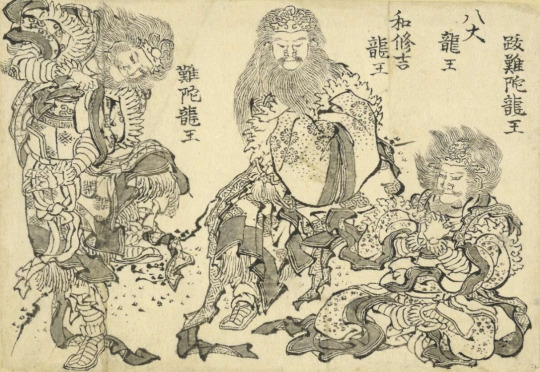
Hokusai's drawing of three dragon kings, including Nanda and Batsunanda (British Museum; reproduced here for educational purposes only)
The final matter that needs to be addressed here is the presence of dragon kings Nanda (難陀) and Batsunanda (跋難陀; Sanskrit Upananda) in Amaterasu’s underworld entourage. In contrast with their peers, they do not have anything to do with Enma. In Buddhist cosmology, they support the cosmic mountain Sumeru, on which the highest devas like Indra and Brahma reside.
More context on their connection to Ise is provided in the treatise Bikisho (鼻帰書), which cites the Outer Shrine priest Tsuneyoshi Watarai (度会常昌; 1263-1339) as its source. It actually states that all eight of the dragon kings are protectors of Ise, though also that only two, one blue and one white (with no names provided), can be used to represent respectively the Inner Shrine and the Outer Shrine. The connection is said to depend on their role as protectors of the Womb Realm and Diamond Realm mandalas. Multiple sources from Ise indicate they were believed to dwell under the central pillars of the Inner Shrine and the Outer Shrine, in this context additionally identified with the cosmic abode of the gods, Mount Sumeru.
Amaterasu, Toyouke and Brahma (times two)

Bonten, the Japanese version of Brahma (wikimedia commons)
While Dainichi made a natural match for Amaterasu, and the reasons behind her association with Enma, while less obvious, aren’t hard to understand either, the third Buddhist figure most commonly associated with her, Bonten, is quite surprising. This deity, the Japanese Buddhist guise of Brahma, has limited presence in popular understanding of Buddhism, but generally much like his Hindu forerunner he is portrayed as a distant deity with limited interest in everyday human affairs. And yet, in medieval Japan Brahma was identified with a figure both commonly worshiped and understood as quite active.
This tradition is documented in Tenshō Daijin Giki. It reaffirms that Amaterasu - seemingly treated as a male figure in this case - is the Japanese guise of Dainichi. However, in the “Realm of Form” - a Buddhist term referring to the world inhabited by humans and deities - he takes the guise of Bonten, and acts as the deva king of Japan. His life will last a total of 105000 years, and he will defend exactly 1000 rulers over the course of this period, before ascending to the Realm of Form to hear the preaching of Miroku. He will also help the faithful reach it.
The already discussed Tenshō Daijin Kuketsu also recognizes the equivalence between Amaterasu with Bonten, though it also furnishes her with a similar connection to the other ruler of the devas, Taishakuten (Indra), and states that both of these equations depend on the doctrine of Abhidharmakośa. Perhaps more unexpectedly, the same work also equates Amaterasu with Shōten (聖天, literally “noble god”; a Japanese form of Ganesha), specifying that this reflects a Shingon view. However, the thirteenth century scholar Ieyuki Watarai (詳細表示; 1256-1356) in his Jingi Hishō (神祇秘抄; “Secret Comments about the Deities”) mentions a different tradition in which this god’s connection with Amaterasu is less direct. He is said to be identical with a nameless “heavenly fox” (天狐, tenko) who acts as her acolyte.
Yet another text already brought up in the previous section, Nakatomi Harae Kunge, does not equate Amaterasu with Brahma outright, but it does redefine terms from classical mythology around him. The High Plain of Heaven (高天原 Takamagahara) is said to be identical with the “First Meditation Heaven of the Realm of Form, ruled by Bonten”. Furthermore, the collective label Yaoyorozu no Kami (八百万の神; literally “eight myriad kami”) is said to encompass “Bonnō, Taishaku, the innumerable devas, the four Great Heavenly Kings, the innumerable devas of Bonnō, and eighty four thousand kami.”
The newfound interest in Brahma in the middle ages reflected an intellectual development arguably unparalleled in earlier Japanese religious tradition - a preoccupation with cosmology.
Kojiki and Nihon Shoki obviously do deal with this topic, but the relevant sections are incredibly brief. This new discourse about cosmology was, at its core, Buddhist, but a major issue was that Japanese Buddhism was not very concerned with cosmology either. The two main sources of inspiration were, therefore, not contemporary Buddhist literature, but Chinese (mainly Daoist) texts on one hand, and accounts of Hindu cosmology, especially the Puranas, preserved in Buddhist sources on the other. Figures such as Pangu, the Three Pure Ones, Shiva or Brahma as a result attained considerable renown among Japanese theologians, who reinterpreted myths about them to suit local context, creating new narratives in the process.

A contemporary statue of Kuni no Tokotachi (wikimedia commons)
In some cases the poorly defined primeval kami from classical mythology could be incorporated into the new visions of cosmology created in the middle ages. Ame no Minakanushi from the Kojiki and Kuni no Tokotachi present both in this work and the Nihon Shoki are both well attested in that context, though references to Ame Yuzuru Hi Ame no Sagiri Kuni Yuzuru Hi Kuni no Sagiri from the Sendai Kuji Hongi can be found too. They were effectively treated as almost interchangeable, or as stages of emanation of the same entity, as documented for example in the writings of the Tendai monk Jihen (慈遍).
Two strains of cosmological speculation, these focused on Brahma and primordial kami, were in particular enthusiastically embraced by the Outer Shrine clergy at Ise, who utilized both of them to improve the standing of Toyouke. As I mentioned before, her role, while seemingly initially relatively minor, grew with time. In many regards, she came to be presented as Amaterasu’s equal. She was furnished with an association with the moon to match Amaterasu’s solar character, for example. The first attempts at elevating Toyouke through theological speculation weren’t necessarily grand in scale. She was simply identified with other kami of similar characters every now and then, for example with Uka no Mitama. An isolated source, a letter from the early Kamakura period, appears to present her identical with Ninigi, Amaterasu’s grandson, instead, but this evidently did not stick.
A breakthrough occurred in the late thirteenth century. The outer shrine clergy developed a view that Toyouke didn’t originate as a servant brought in to deal with Amaterasu’s loneliness and other needs, but rather a primordial kami, identical with Ame no Minakanushi or Kuni no Tokotachi. Toyouke in this guise was the foremost kami of heaven, and Amaterasu “merely” the foremost kami of earth.
However, as I already pointed out, the new cosmologies which influenced this reinterpretation of Toyouke depended not only on classical mythology. Therefore, the Outer Shrine’s kami could also be identified with Brahma, or credited with controlling the proper flow of qi and thus yin and yang, following a Daoist model. Much of this theological speculation might have originated in the works of a single priest, Yukitada Watarai (度会行忠; 1236-1305), though he was far from the only contributor.
It’s worth pointing out that there was a practical material component to the theological speculation about the identity of Toyouke. Regardless of the relation of their respective kami, Inner and Outer Shrine were ultimately rivals competing for patronage. To present Toyouke as equally, if not more, important as Amaterasu was also a way to make potential donors, from shoguns to commoner pilgrims, more inclined to support the Outer Shrine. While prior to the Kamakura period Ise could securely depend on imperial funding alone, that changed with the weakening of the court. Therefore, securing new supporters was vital for their continuous activity. This remained the case through the Edo period as well, but this topic obviously goes beyond the scope of this article.
Identification of both Toyouke and Amaterasu as Brahma was not necessarily contradictory thanks to the existence of sources in which more than one Brahma appears. Nobumi Iyanaga points out that two Brahmas, Mahābrahmā Śikhin (ie. Brahma as the king of the gods) and Mahābrahmā Jyotiṣprabha (“Great Brahma of Brilliant Light”), appear in the Yamato Katsuragi Hōzanki (大和葛城宝山記), with one reflecting traditional portrayals of Brahma and the other representing a reinterpretation of an account of Vishnu as a creator figure. Both of the titles used appear in the enumeration of deities listening to the Buddha’s teachings in the Lotus Sutra. Two Brahmas also appear in the Bikisho, where “king Brahma” descends from heaven, but instantly starts longing for a friend. In response, a deity named Harama, an alternate transliteration of Brahma into Japanese, appears to him.
The notion of Toyouke and Amaterasu being two Brahmas might have developed in the thirteenth century at Senkūin, a Buddhist temple closely affiliated with the Ise shrines. A text from this location dated to between 1240 and 1275 states that Toyouke, addressed as identical with Ame no Minakanushi, corresponds to Shiki Daibontennō (尸棄大梵天王; “emperor Mahābrahmā Śikhin”) and Amaterasu to Kōmyō Daibontennō (光明大梵天王; “emperor Mahābrahmā Jyotiṣprabha”). It also specifies Toyouke is male and Amaterasu female, which reflects splitting Brahma into a male-female cosmogonic pair. Nobumi Iyanaga points out the theological treatise Tenchi Reikiki (天地麗気記) goes a step further: the two deities are said to partake in intercourse. He suggests this represents a development of the motif of Brahma longing for a friend in the Bikisho. Tenchi Reikiki also states the couple personifies the Womb Realm and Diamond Realm.
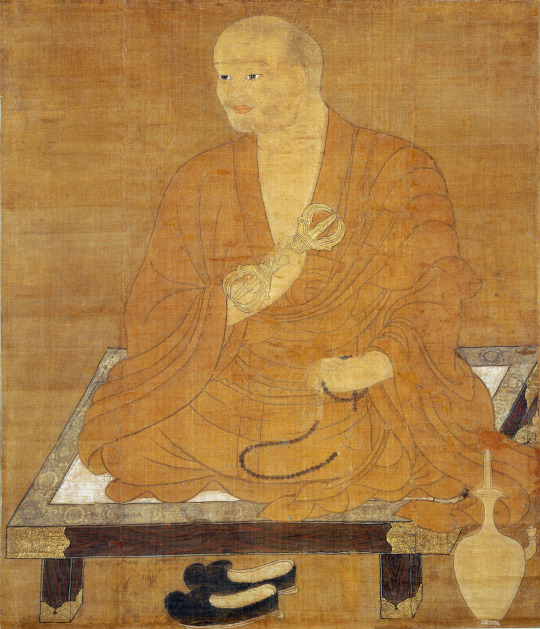
A Kamakura perioid painting of Kūkai holding a vajra (wikimedia commons)
As a digression it’s worth pointing out that while the Tenchi Reikiki was only written in the Kamakura period, it was actually attributed at the time to Kūkai, who lived centuries earlier. Obviously one reason was that there’s no better way to make a treatise seem more authoritative than to claim it was written by a celebrated historical figure. However, it’s also worth pointing out that at some point a connection between Kūkai and Amaterasu developed. A tradition known from a number of works, for example Monkan’s treatise Himitsu Gentei Kuketsu (秘密源底口決) presents him as a manifestation of her.
The Watarai theories about the nature of Toyouke and Amaterasu have originally been written down in the Kamakura period in the so-called “secret books''. This term has been used to refer to them collectively since the Edo period, when they were standardized for a relatively brief time into a “canon” of sorts. While tradition has it that there were five of them, research revealed the existence of further texts in medieval tradition, with one rediscovered in 1955, for example.
At least in theory, the individual Watarai books present information contained within as a special sort of secret, designated by the Buddhist term shōgyō (聖教; literally “sacred teachings”). Originally it referred to the teachings of the historical Buddha, or to the Buddhist canon more broadly, but in medieval Japan the term came to refer to specific kinds of knowledge transmitted by monks and other religious specialists in general.
While sometimes referred to as “secrets” in English, shōgyō were not necessarily impossible to share. Through the entire middle ages, many temples and shrines all across Japan effectively actively built their identity around making it known that they possess religious secrets worth knowing and can transfer them. Sometimes, they were intentionally “leaked” to nobles, imperial courtiers or fellow clergymen to spark interest. They were also utilized in annual “debate rituals” (論義会, rongie) held by authorities for religious scholars, who treated them as a way to hone their rhetorical skills and gain new theological insights.
The divine and the vulpine at Ise: Amaterasu, Dakiniten and Sankoshin

The Dakiniten mandala (wikimedia commons)
The topic of shōgyō is fundamentally linked with ambivalent Buddhist figures which in medieval Japan came to be associated with the notions of non-duality combining enlightenment and ignorance, such as dakinis, which commonly figured in such “secrets”. While dakinis do not appear in the cosmological myths from the Watarai books, they nonetheless did play a role in the developments pertaining to medieval Amaterasu. A link between her and the dakini par excellence, Dakiniten, developed due to their shared connection with Dainichi. Under his original name Mahavairocana, Dainichi can be portrayed as a subduer of dakinis, taking the guise of Mahakala (Makaraten) in this context. The singular Dakiniten as a result of this association could be identified with Dainichi outright, as attested in the Rinnō Kanjō Kuden (輪王灌頂口傳), dated to the late Kamakura period.
The link between Amaterasu and Dakiniten is chiefly known from the Shingon ritual sokui kanjō (即位灌頂), “enthronement initiation”, meant for emperors freshly ascended to the throne. It was first performed for emperor Fushimi in 1287, and remained a part of ascension ceremonies all the way up to 1846. In this context, Amaterasu outright appears in the guise of Dakiniten. A similar statement can be found in Tenshō Daijin Kuketsu, which calls Dakiniten the honji of Amaterasu (it also links Dakiniten with Fujiwara no Kamatari and the rise of the Fujiwara clan, but I’ll cover that elsewhere in the future).
Keiran Shūyōshū specifies that the shinko was an appropriate form for Amaterasu because it is the only animal capable of emitting light on its own. This ability in turn reflects the fact that its body was identical with the wish-fulfilling jewel, a frequent attribute of Buddhist figures; the name is self-explanatory. Alternatively, the animal could be described as possessing three tails, each ending in a wish-fulfilling jewel. By the fourteenth century, this object was firmly associated with Amaterasu as well. This led to the development of the view that Nyoirin Kannon (如意輪観音), a form of Kannon directly linked to the wish-fulfilling jewel, was Amaterasu’s honji. The shinko similarly could be identified with this bodhisattva. Granted, so were prince Shotoku, Ryōgen and numerous other figures, but that’s a separate topic not directly relevant to this article.
A different belief developed around the shinko at Ise. Here this supernatural animal came to be identified with Sankoshin (三狐神), literally “three fox deity” or “three fox deities”. Despite the triplicity implied by the name, sources such as Tamakisan Gongen Engi (玉置山権現縁起) clearly describe Sankoshin as a singular figure who acted as the “king of the heavenly foxes” (天狐王, tenko-ō).
It is presumed that Sankoshin's name was in origin a derivative of Miketsu no Kami (御食津神), the kami of Miketsu, the granary of the Outer Shrine. The development of Sankoshin might have started as a misreading or wordplay, with Miketsu (御馔津) transformed into the homophone mi ketsu, “three foxes” (三狐). This phrase in turn can be alternatively read as sanko, as in the case of Sankoshin.
Miketsu no Kami is otherwise associated, or outright identified, with Uka no Mitama, who is obviously not a fox, let alone three foxes; or alternatively with Toyouke, who has even less to do with these animals; you might recall she is described as a miketsu kami in the legend of her arrival in Ise. Older copies of Nakatomi Harae Kunge also affirm this equation, but later on the reference was substituted for a statement supporting the equivalence between Toyouke and Ame no Minakanushi favored by the Watarai priests.
Sankoshin in the middle ages appeared in rituals from Ise associated with the kora (originally 子良, later also 狐良). This term refers to a class of female shrine attendants associated with the Outer Shrine at Ise. Jingi Hishō asserts they were manifestations of Dakiniten, and on the basis of homophony links their name with 狐 (ko), “fox”.
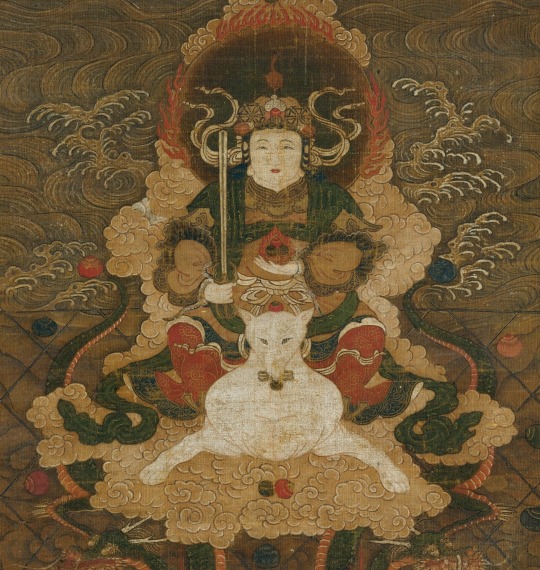
Part of a hanging scroll depicting Dakiniten riding on a fox (wikimedia commons)
Elsewhere, shinko is treated as another name of Dakiniten, or alternatively of her fox mount (which lacks serpentine traits proposed by Teeuwen, but sometimes does have snakes coiling around its legs and neck). It’s also a part of her well attested epithet Shinko-ō Bosatsu (辰狐王菩薩), “Bodhisattva King of Astral Foxes”. This connection is also partially responsible for the development of another of her titles, Shindamani-ō (真陀摩尼王), “king of the wish-fulfilling jewel”.
Being able to grant specific wishes immediately was commonly attributed to Dakiniten in the middle ages and beyond. However, due to her ambivalent perception and peripheral role between devas and demons in Buddhist theology it was commonly believed that the worldly benefits granted by her do not last and in the long run might lead to misfortune. With time, related rituals often came to be perceived negatively, often based on highly dubious reasons, as I discussed recently in another article. The ambivalent perception of Dakiniten ultimately was not unlike that of the animals she came to be associated with.
I plan to cover Dakiniten in more depth at some point, but I will only note here that her connection with foxes has a rather interesting history. Originally, dakinis were associated with jackals in India, due to their similarly unfavorable perception. When Buddhist texts dealing with this topic were transmitted to China, references to these animals posed a challenge to the translators, who were entirely unfamiliar with them. Based on context it was established that the name of a fox-like legendary animal, the yegan (野干), would make for a sensible translation. Since the yegan was described as fox-like, and since foxes in general had a major role in religion and literature of China at the time, eventually comparisons with foxes started to show up. Most notably, in the Tang period Śūraṅgama Sūtra the word dakini is provided with the gloss humei gui (狐魅鬼), something like “fox sorceress demon”. While unique, this term might have influenced the development of the image of dakinis in general, and Dakiniten in particular, in Japan.

A thirteenth century depiction of Benzaiten with entourage (wikimedia commons)
To go back to the core topic of this section, the development of a link between Amaterasu and Dakiniten had one more consequence: the establishment of a similar connection between Toyouke and closely related Benzaiten at Ise, to keep the theme of mirroring associations. This goddess is the Buddhist form of Saraswati. Today, she is best known as one of the Seven Gods of Luck, who emerged as a group in the Edo period, though her history goes further back and she enjoyed considerable popularity through the middle ages.
Outside of Ise, it was commonly Amaterasu herself rather than Toyouke who came to be linked to Benzaiten. According to a legend which originated on Chikubu Island, Benzaiten first appeared in Japan during the reign of emperor Kinmei, and instantly announced she is a manifestation of Amaterasu. A less direct reference might be present in the already mentioned Taiheiki, where Yoshisada Nitta at one point says he heard Amaterasu at times manifests in the form of a “dragon god of the blue ocean”, which might be an allusion to a common symbol of Benzaiten.
Benzaiten and Amaterasu could also be associated without being identified with each other. In a myth tied to the tradition of wandering blind singers (a group traditionally believed to be under her protections), she effectively replaces Ame no Uzume, and lures Amaterasu out of the cave by playing her biwa. In the Asamayama Engi (朝熊山縁起), she is addressed as Amaterasu’s mother instead, though she ultimately only plays a minor role in contrast with her daughter. The text largely revolves around Amaterasu (as noted by Anna Andreeva portrayed here as a “great conversationalist”) explaining theological matters to the monk Kūkai.
Amaterasu, Aizen and sericulture

The wisdom king Aizen (Metropolitan Museum of Art)
In addition to her links to Buddhas and devas, Amaterasu also offers an example of identification between kami and wisdom kings. They enjoy an elevated position among Buddhist figures, almost on par with Buddhas and bodhisattvas. She could specifically be identified with arguably the second most important member of this category, Aizen Myōō. Since he is regarded as a wrathful manifestation of Dainichi, the reasons appear fairly straightforward. Linking him with Amaterasu goes back at least to Eison, a long-lived thirteenth century Shingon monk. The connection additionally reflects Amaterasu’s association with the wish-fulfilling jewel. Aizen was outright identified with this object, which is actually responsible for many of his own associations. Last but not least, Aizen and his fellow wisdom king Fudō were identified with the same two mandalas as the two shrines of Ise. On this basis it was not hard to link Aizen with Amaterasu.
However, once again, association does not necessarily equal conflation. Therefore, Aizen and Amaterasu could also appear as two distinct figures in the same sources. For example, both textual and iconographic instances of a triad consisting of both of them and another wisdom king, Fudō, are known. The occasional identification between Aizen and Amaterasu is not the reason behind his appearance here. Instead he and Fudō are present because they are an archetypal Buddhist dyad used to represent duality.
The triad is a medieval reinterpretation of the cave myth which played a role in an initiation rite (灌頂, kanjō) focused on Amaterasu. In this context both of the wisdom kings take the roles of “rock cave assistants”, with Fudō corresponding to Takuhatachijihime (the mother of Ninigi and younger sister of Omoikane) and Aizen to Tajikarao (who famously opens the cave in the classical version of the myth). The opening of the cave Amaterasu hid herself in was compared to the opening of the legendary Iron Stupa, said to exist somewhere in the south of India. This event, as Buddhist treatises record, led to the reveal of esoteric knowledge to the early Mahayana thinker Nagarjuna. In Tenshō Daijin Kuketsu, it is actually Amaterasu herself who was transmitted to him by the bodhisattva Kongōsatta (Vajrasattva).
To go back to the depictions of the Amaterasu triad, another thing worth pointing out is that a unique iconographic variant of her appears in them: seated on the back of a horse, with a solar disc and scales in her hands. While at a first glance this might sound similar to already discussed Taga Myōjin, there is actually a difference: the latter is always depicted frontally, not facing left, in contrast with the other mounted form of Amaterasu.

A depiction of Memyō from the fifteenth or sixteenth century (Metropolitan Museum of Art)
However, Bernard Faure notes these paintings resemble yet another figure she could be equated with, Memyō Bosatsu (馬鳴菩薩; “horse neigh bodhisattva”). This name originally referred to the Buddhist author Aśvaghoṣa, but in this context it instead designates a sericultural deity of Chinese origin first attested in the Tang period, for example in a short text attributed to Varjabodhi. However, while the Chinese original, Maming Pusa, is male, his Japanese counterpart is generally portrayed as a female figure, especially in texts stressing her connection to Amaterasu.

A Meiji period illustration of Susanoo throwing the carcass of Ame no Fuchikoma into Amaterasu's weaving hall (wikimedia commons)
Presumably the two initially came to be associated with each other because of their shared interest in sericulture and weaving. The classical myth portraying Amaterasu as a weaver, in which Susanoo throws the carcass of the horse Ame no Fuchikoma into the room where she is engaging in this craft, has been channeled to highlight why she would be identified with a deity portrayed on horseback.
While Memyō is arguably the highest profile Chinese figure Amaterasu was identified with (unless you want to make a case for Enma but that would be a bit of a reach), it’s worth noting that there’s another such case. However, it involved a historical figure rather than a deity. While presenting Buddhist patriarchs or rulers as manifestations of Buddhas or deities was par for the course, this one strikes me as quite unique.

Yang Guifei, as depicted by Shōen Uemura (wikimedia commons)
Jindai no Maki Hiketsu (神代卷祕決) records a tradition according to which Yang Guifei, a consort of emperor Xuanzong of Tang, was a manifestation Amaterasu. It depends partially on the preexisting belief that the former did not commit suicide, but instead escaped to Japan, and came to be enshrined in the Atsuta Shrine, which on the account of its picturesque location was sometimes identified with Penglai, the land of Daoist immortals. A related legend is recorded in the sixteenth century treatise Utaishō (謡抄), which relays that the Atsuta deity (here not identified with Amaterasu) manifested in China as Yang Guifei to seduce emperor Xuanzong to distract him with a plan of invading Japan. After accomplishing this goal, she returned to her shrine.
Emperor Xuanzong wasn't exactly the conventional nemesis of Amaterasu, whether in classical mythology or in the middle ages. I'll look into the figures such a title can be applied to in in the second half of this article; due to tumblr's limits I cannot publish both halves as a single post. The bibliography will also be included in part 2.
86 notes
·
View notes
Text
Watch: A Bat Lands On THE PRETTY RECKLESS Singer TAYLOR MOMSEN's Leg During Concert In Spain

According to Metal Journal, a bat landed on the left leg of THE PRETTY RECKLESS singer Taylor Momsen during her band's May 29 performance at Estadio La Cartuja in Seville, Spain as the support act for AC/DC.
After playing the fifth song of THE PRETTY RECKLESS's set, "Witches Burn", Taylor addressed the crowd, saying: "You guys are pointing at something, and I wanna know what you're saying." She then looked down at her leg and noticed the bat, after which she return to the microphone and exclaimed: "There's a fucking flying bat on my leg right now. Can someone help me, please? I must really be a witch."
A stage quickly hang came over a removed the bat, prompting Taylor to say: "Gracias. It's all right. And the bat's fine. He's gonna be my new friend," before adding, "Holy fuck."
Guitarist Ben Phillips then told the crowd: "Well, that hasn't happened before." Momsen went on to say: "I'm telling you. I'm a fucking witch. I attract the bats. Someone, bring out a black cat. It's gonna be great."
Phillips said to the audience, "Gracias for pointing it out," before Momsen added: "I thought you were pointing at my SOUNDGARDEN bracelet. And I was, like, 'Oh. Fucking they like SOUNDGARDEN. Awesome."
During an appearance on the May 6 episode of SiriusXM's "Trunk Nation With Eddie Trunk", Taylor was asked about the progress of the songwriting and recording sessions for THE PRETTY RECKLESS's fifth album. She said: "I don't have [release] dates for you, but we booked — we've locked up the studio for eight months. It takes us a while to make a record. But it was going amazingly [before we paused the sessions in order to hit the road]. Hopefully when we pick back up in September, it'll be the same kind of flow and everything will just jell. But a lot of it's written. I'm sure that more will be written when these experiences happen and then new songs [arise] out of them. So I'm sure that there'll be some more songs coming. But I don't have dates. But it was going great, and we had just started; we really haven't started at all, but there's written stuff. So that's a start, I guess. But as far as recording, we hadn't really gotten into it yet."
This past January, THE PRETTY RECKLESS shared a photo of Taylor in the studio with Jonathan Wyman, who co-produced THE PRETTY RECKLESS's latest album, 2021's "Death By Rock And Roll", apparently confirming that Wyman has re-teamed with the group for the upcoming LP.
In a May 2023 interview with Ronni Hunter of the 99.7 The Blitz radio station, Momsen revealed that she and her THE PRETTY RECKLESS bandmates had commenced work on the follow-up to "Death By Rock And Roll".
"We're in a great headspace," she said. "We're just having fun with it, and wrapping up the tour cycle of 'Death By Rock And Roll'. And then new record — and it's next chapter. We've already kind of started it… We've gotten into a studio; we've stepped foot into a studio. So that's saying something for us."
THE PRETTY RECKLESS is supporting AC/DC on the legendary hard rock band's spring/summer 2024 European tour. Momsen and her bandmates also opened for THE ROLLING STONES on May 11 at the Allegiant Stadium in Las Vegas, Nevada.
In November 2022, THE PRETTY RECKLESS released a new collection of music, "Other Worlds", via Fearless Records. The effort saw the group delivering its first proper acoustic recordings, unexpected covers and other reimaginings.
"Death By Rock And Roll" was made available in February 2021 via Fearless Records in the U.S. and Century Media Records in the rest of the world.
Upon release, "Death By Rock And Roll" topped multiple sales charts — including Billboard's Top Albums, Rock, Hard Music, and Digital charts. The record also yielded three back-to-back No. 1 singles — "Death By Rock And Roll", "And So It Went" (featuring Tom Morello of RAGE AGAINST THE MACHINE) and "Only Love Can Save Me Now" (featuring Kim Thayil and Matt Cameron of SOUNDGARDEN). The band has tallied seven No. 1 singles at the rock format throughout its career.
"Death By Rock And Roll" was THE PRETTY RECKLESS's first album to be made without longtime producer Kato Khandwala, who died in April 2018 from injuries sustained in a motorcycle accident.
THE PRETTY RECKLESS formed in 2009 and consists of Momsen, Phillips, bassist Mark Damon and drummer Jamie Perkins.
In 2021, Momsen — who rose to fame portraying the character of edgy little sister Jenny Humphrey on The CW's "Gossip Girl" — described "Death By Rock And Roll" in an interview with ABC Audio as a "battle cry for life and for hope."
"I think that that's something that we can all use a little bit more of, especially right now," she said. "We could always use a little more hope, and we could always use a little more rock and roll."
youtube

21 notes
·
View notes
Text
The Surprising Reason John Larroquette Took His Career-Defining Role on 'Night Court'
The comedy ninja reveals all this week's 'Parade' cover story.
MARA REINSTEIN
UPDATED:JAN 19, 2023

Get in a car and drive about 30 miles north of Portland, Oregon, into southwest Washington. That’s where you’ll find actor John Larroquette.
He and his wife, Elizabeth, have lived on a piece of rural property for about five years. He collects books and likes to narrate plays in his home recording studio. Sometimes the couple head into the city to try new restaurants and go to the theater and concerts. “It’s really beautiful,” he says. “And at my age, it’s time to slow down and be out somewhere.”
In fact, Larroquette is so fond of his far-from-Hollywood lifestyle that not too long ago, he considered himself retired from the business with a fulfilling career and a room full of trophies to show for it. Never did he think he’d return to grueling TV work, let alone reprise the very role that made him a household name.
Guess what happened next?
Yup, Larroquette, 75, is suiting back up as wise-cracking, endearingly smarmy lawyer Dan Fielding in a new version of the irreverent sitcom Night Court (premiering Jan. 17 on NBC). Set decades after the 1984-92 original, it still chronicles the colorful cast of characters passing through the New York City after-hours courtroom. But now, the Honorable Abby Stone (Melissa Rauch), the daughter of Judge Harry T. Stone (Harry Anderson), bangs the gavel.
Fielding starts the series as a process server, though not for long. “As an actor, I thought it would be an interesting idea to revisit a character 35 years later in his life and see what happened to him,” Larroquette says. “I can’t do the physical comedy and jump over chairs anymore, so my conversations with the producers were about how to find the funny.”
Call it the latest unexpected turn for a seasoned star who began his professional journey as a DJ for “underground” radio in the 1960s, moved from his native New Orleans to Los Angeles to jumpstart his career, once took a gig in exchange for marijuana, played a Klingon in the third Star Trek movie and completed rehab to kick his heavy drinking—all before his very first audition for Night Court in 1983. After the sitcom’s last episode, he won his fifth Emmy (for the drama The Practice) and a 2011 Tony for the Broadway revival of How to Succeed in Business Without Really Trying. He and Elizabeth, wed for 47 years, have three grown children.
“I honestly wish I had a tape recorder going at all times because he’s led such an interesting life and has such wonderful stories,” marvels Rauch, his co-star and a Night Court executive producer. “He’s super-quick, funny and definitely tells it like it is.”
Exhibit A? His interview with Parade, in which he discusses life and death, and everything in between.
Did you sign on to the series right away or was it a tough sell?
When Melissa [Rauch] presented the idea to me, I immediately said, “No thank you.” I didn’t like the idea of being compared to my 35-year-old, younger self. These conversations went on for a year. Then, one day, she told me that she wanted to be on-camera as well, so I decided to try and do it. We ended up pitching the show together, and it got picked up. You know, in New Orleans, there’s a French word called “lagniappe,” which means “a little bonus.” That’s what I consider myself. She’s the heart of the show.
Sadly, a few of your co-stars—including Harry Anderson and Markie Post—have died in recent years. What was it like being on the set without them?
Very emotional. Harry passed away in 2018, but it’s still a tender spot in my heart because he and I were together for a long time even outside of work. Markie and I were very close, and we had exchanged a few emails about the show before she died [in 2021]. She was a big cheerleader for it. And Charlie [Robinson, who played the clerk “Mac”] died when we were shooting the pilot last year. I saw him a lot because we both love the theater. Being on the set—I don’t say this glibly—but it was like seeing dead people. I’d always remember how I had this bizarre and completely sincere family for nine years.
Going back to the 1980s, why did you originally take the Dan Fielding role?
It was a paycheck. This was 1983, and I was still a journeyman actor going from job to job. I was a regular on a series in the ‘70s [Baa Baa Black Sheep], but then I took a few years off to do some extremely heavy drinking. After I got sober and realized I wasn’t going to die, I thought, “What am I going to do?” I had been in a pretty big [1981] movie called Stripes with Bill Murray. I read for Ted Danson’s role in Cheers.
Wait, how far did you get in the Sam Malone casting process?
Oh, I just walked in and did a cold reading along with every other 32-year-old actor at the time. But then I auditioned for the judge in Night Court. The producers asked me to read for this other role of Dan Fielding and I said, “Sure.” Even if I hated the role, I would have taken it because I needed to make money to help pay the rent and support my family and be a responsible member of society. It was luck that I really liked it. Then I got lucky again when NBC picked up the show as a mid-season replacement.
During the height of the show’s popularity, you earned four consecutive Emmys for your performance. That must have felt beyond validating.
Obviously, being acknowledged by your contemporaries was an incredible honor. I don’t say that blithely. It was a remarkable, remarkable feeling. And I was up against some formidable talent—mainly all those guys from Cheers.
Why do you think the character was and is so appealing?
I think because he allowed the audience to know that he wasn’t a bad guy. He was more like a feckless buffoon. He also really wanted to be loved. As a matter of fact, in our pitch, we screened an old scene of Fielding in a hospital bed telling Harry, “I don’t have a life; I have a lifestyle. Nobody has ever said, ‘I love you.’” So when we find Fielding again, he’s loved and lost. And Harry’s daughter forces him out of his cave. It’s a real full-circle moment.
Let’s go back to your own start. Did you have any music skills coming out of New Orleans?
Well, I started playing clarinet in third grade, then I moved to the saxophone in the 1960s. But I euphemistically say that I could talk better than I could blow. So, I took that sax out of my mouth and became a DJ and started using my voice as much as I could. I’ve always loved the analog aspect of audio. I still have some reel-to-reel tape recordings and old microphones.
Is that how you ended up narrating the opening prologue for [the 1974 horror classic] The Texas Chainsaw Massacre?
No, no, that wasn’t through any kind of past work. In the summer of ‘69, I was working as a bartender at a small Colorado resort in a little town called Grand Lake because I wasn’t sure what I wanted to do with my life. [Director] Tobe Hooper happened to be in town and we became friendly. Flash forward four years, and I found myself in L.A. collecting unemployment checks and trying to decide if I wanted to be an actor. Tobe heard I was in town and asked for an hour of my time to narrate something for this movie he just did. I said, “Fine!” It was a favor.
Per the Internet, he gave you a joint in lieu of payment. True?
Totally true. He gave me some marijuana or a matchbox or whatever you called it in those days. I walked out of the studio and patted him on his back side and said, “Good luck to you!” Now, I have also narrated the consequential films and did get paid. You do something for free in the 1970s and get a little money in the ‘90s. I’m not a big horror movie fan, so I’ve never seen it. But it’s certainly the one credit that’s stuck strongly to my resume.
But you’ve appeared on the big screen plenty of times. Did you have movie-star aspirations following all your TV success?
The movies I’ve done are mostly forgettable. Blind Date [from 1987] is an exception, but that’s because of Bruce Willis and Kim Basinger. And Blake Edwards directed it. It was funny. But my face is not made for a really big screen. It’s a broad, clown-like face. It’s good for a TV two-shot. And you ride the horse in the direction that it’s going and television was always right there and offering me stuff, so I kept doing that.
You also performed in a musical for the first time in How to Succeed in Business Without Really Trying in 2010. How was that change of pace?
I was hesitant to do it because I had never sung and danced on stage. I was convinced I was going to be fired in the first two or three weeks. I’d keep going in my head, “five, six, seven, eight!” just trying to get the steps down. But I loved the lifestyle of being a stage actor in New York. I loved working with Daniel Radcliffe, and we became fast friends. It got to a point where I couldn’t wait to get to the theater and try it again that night. If you’re given the opportunity to do something that may be a stretch, I think it’s important to try and see if you can pull it off.
Can you talk a bit about your personal life? You seem a little reclusive.
Reclusive isn’t accurate, but I’m definitely an introvert. Elizabeth and I met doing the play Enter Laughing and got married in 1975. She puts up with me, and you can’t ask for much more than that. Our kids are grown. My daughter Lisa is a graphic designer and my son Jonathan has had a podcast for the past 17 years called Uhh Yeah Dude. And my youngest son, Ben, is a musician who graduated from the Berklee School of Music. He actually composed the new theme music for Night Court. They’re all lovely, and I love them dearly.
That’s quite a professional and personal success story, no?
You know, considering where I’m from and the kind of culture I grew up in, yes. I’ve been very successful in my chosen field. And I’m grateful for having done that because there were times when I thought I would not live, much less have a career. It’s nothing to be taken for granted. But I’m very old now. Three quarters of a century. I’m sort of playing with house money from now on, regardless of what happens.
Sorry, but 75 isn’t very old!
Yes, it’s old. It’s old. Please. It’s old. There are certainly people who live longer, but I can go down the list of wonderful friends and coworkers who are now deceased. One being Kirstie Alley, my costar in [the 1990 comedy] Madhouse, who was younger than I am. She was a lovely person, and so funny. There are only a few more exits on the freeway and you’ve got to choose one. But I’m not afraid of the hereafter and I don’t bemoan it. It’s been an interesting ride, and all rides eventually end.
Do you have any sort of words to live by?
As corny as it sounds, take things one day at a time. You know, I learned when I stopped drinking at age 32 that all you have is right now. Use the present in your life as much as you can.
Source: https://parade.com/celebrities/john-larroquette-night-court-cover-story
-----
My thoughts (please feel free to ignore):
I'm sure someone in the fandom has already posted this interview John did last year with Parade magazine when the new Night Court premiered. But I can say that it's new to me, so I'm sharing it in case it's new to someone else too.
I apologize for the highlighted purple sections above. That's just me marking the parts of the interview that resonated with me the most.
I don't know about anyone else, but some parts of his answers to the questions made me feel kind of sad. Partially because he's clearly experiencing grief at the loss of his friends. And partially because John himself may not be with us for much longer (although I hope I'm wrong and he beats Betty White to 100).
But I was talking to my mother about some of his answers, and she said that as someone who has reached an age milestone herself, she understands his perspective. And I guess I do too.
It's important to remember that in any other profession, John would likely be retired by now. So we should really be grateful for any roles he takes or public appearances he makes, and hope that his days ahead are filled with the calm, joy and laughter that he so rightly deserves.
#john larroquette#new night court#night court#fandom#interview#parade magazine#night court 2023#bittersweet
22 notes
·
View notes
Text

FIC MASTERLIST
WIP Series - Stranger Things
Cruel Summer (AO3)
The Eddie Munson speedway AU no one asked for. Enemies to friends to lovers. No Upside Down, no use of Y/N. Fast cars, fast times.
Tumblr
Chapter 1 | Chapter 2
Completed Series - Inuyasha
The Fifth Flavor
Grumpy-sunshine photographer Inu, chef Kagome. Enemies to lovers. Ramen is made.
Entitled to You
MirSan two-shot featuring books, misunderstandings, fake-dating. Disabled Miroku and wingman Jakotsu.
Just Another Day in the Life of Superheroes *group fic*
Inu Gang, but it's the Incredibles. I wrote Chapter Four.
WIP Series - Inuyasha
I Love the Flaws You Try to Hide *WIP, hope to update soon*
When Kagome Higurashi wakes up on the morning of her 21st birthday to find that she doesn't have a soulmate mark, she doesn't know what to do.
Kotodama *WIP, hope to update soon*
A modern InuKag friends-to-lovers, high school AU with powers, gangsters, words that mean more than words, and a cross-class romance.
I Can Quit Anything, But I Can't Quit You *on hold*
Inuyasha is a professional "quitting consultant" and Kagome can't find the perfect job.
One-shots - Inuyasha
Sing, My Little Bird
An Inuyasha homage to Angela Carter's "The Erl-King."
Skeins and Schemes
Kagome wants to make Inuyasha an extra special Christmas gift. Canon-compliant, sweet, sweet fluff.
You've Got a Read on Me
InuKag coffee shop meet-cute with tarot cards.
Tasting Spoons
Part of the TFF universe. A sweet-spicy one-shot complement, featuring licking and chocolate.
In My Pulse, There Is Only You
Reverse Bang 2021 for Art Inu-spiration with @kirrtash. Mind control, angst, pining, ambiguous ending. My fav.
Constellation Consolations
Since she's returned to the Feudal Era, Inuyasha notices that Kagome's always sleepy. A sweet little post-marriage InuKag story.
I Don't Need Perfection
Friends to lovers InuKag. There's only one bed.
Lae's IY Ficlets *ongoing one-shots*
Inuyasha drips and drabs.
Unpublished WIPs - Titles
These will some day make it out of my brain.
Werewolf
Iscariot
Rural Shenanigans
Hello, Harbinger
#inuyasha#inuyasha fanfiction#inuyasha fanfic#inukag#mirsan#fanfiction#fanfic#a03 fanfic#stranger things fanfiction#strangerthings fanfic#eddie munson x reader#eddie munson x fem!reader#eddie munson x you
50 notes
·
View notes
Text
It was the literary scandal of the decade, the ultimate betrayal and, it turned out, the end of Truman Capote’s career. Published in Esquire in November 1975, “La Côte Basque 1965”, an excerpt from Capote’s then-forthcoming novel Answered Prayers, saw the celebrated writer share the innermost secrets (and most scandalous gossip) entrusted to him by his beloved Swans, the wealthy and glamorous group of high-society women that included Babe Paley, Slim Keith, Gloria Guinness, Lee Radziwill, Marella Agnelli and CZ Guest.
Visceral in its revelations of substance abuse, sexual assault, a murder cover-up, a graphic description of extra-marital period sex and, to top it off, bestiality, the article was a sensation for all the wrong reasons. It saw Capote deserted by his closest friends and shunned from the New York clique he had yearned to be a part of growing up – and, against the odds, had managed to infiltrate as an adult thanks to the success of his novels In Cold Blood and Breakfast at Tiffany’s.
Capote’s questionable actions (and the irresistible drama they precipitated) form the backbone of Ryan Murphy’s long-awaited Feud, inspired by Laurence Leamer’s bestselling 2021 book, Capote’s Women. An all-star cast will bring the man and his muses back to life when the Gus Van Sant-directed series premieres this month on FX in the US, but what was the real-life fallout from the publication of “La Côte Basque 1965” like for Capote and co?
“He never recovered from it,” says Ebs Burnough, director of the 2021 documentary The Capote Tapes, a five-year discovery project that saw him uncover hours of audio footage of Capote, and which gives the most thorough insight into the flawed figure to date. “[These were] friendships born and nurtured over 20-something years. All of a sudden, not one but all of his friends – who had been like his family, because he didn’t really have any family – were not speaking to him; there was literally nowhere for him to go. He was alone drinking, and the phone stopped ringing. He was a man alone on an island.”
Described by the New York Times as “the high-society temple of French cuisine”, La Côte Basque – just off Fifth Avenue and a stone’s throw from The Plaza – was a fine-dining eatery as famous for its juicy gossip as it was for its succulent Coeur de Filet Périgourdine. No one, however, dared to write about what was said and done there – until Capote. While his ostracising may seem like an obvious consequence for spilling society’s sordid secrets, Capote was flawed by the outrage.
Before publication, he boasted to People that he was planning on assassinating his characters with a pen instead of a gun: “There’s the handle, the trigger, the barrel, and, finally, the bullet. And when that bullet is fired from the gun, it’s going to come out with a speed and power like you’ve never seen – wham!”
Success was, in his head, assured, as Capote had been open about writing “La Côte Basque 1965”, bragging about the stories he would tell, continues Burnough. “He was working on that piece for over 20 years, so in his mind he didn’t anticipate the fall out because all of them knew he was working on it.” Upon the outrage, Capote was, “totally abandoned but also indignant”, he continues. “He even said, ‘Hey! What did they expect from me? I’m a writer!’”
Capote had form. “Remember, this was something he had done with Breakfast at Tiffany’s,” explains Burnough. “When you think about it, Holly Golightly is essentially a call girl, yet with Audrey Hepburn [playing her], and because it was so beautifully written, lots of New York socialites were saying, ‘Holly was based on me!’ There’s [even] a quote in The Capote Tapes where Babe’s daughter [Kate] says, ‘Mummy was so excited to be immortalised by such a famous author.’ So, I think he was certainly expecting great praise.”
Babe Paley was Capote’s most aggrieved victim of “La Côte Basque 1965”. In it, Slim Keith’s alias, Lady Ina Coolbirth, reveals to the fictionalised version of Capote, PB Jones, the story that Paley is said to have told Capote about catching her husband, CBS head Bill, in bed with another woman. When Capote rang the Paley household to see what they thought of “La Côte Basque”, Bill is said to have lied, claiming that it was thrown out before either of them could read it; a distraught Babe, who had read it, and who considered Capote her closest confidante, had terminal lung cancer at the time of its publication and never spoke to Capote again before her death in 1978.
Such dismissal of his work would have affected Capote, says Burnough, but the fallout from the Swans leaving him would have been even worse. “Babe Paley was his North Star. She was everything he aspired to be and everything his mother aspired to be. [His mother] had always wanted to be a socialite, so his obsession came from her wanting but not being a part of that world, and then abandoning him as a child. There’s a lot of mother psychology there.”
It makes total sense that Babe Paley was the victim of Capote’s worst betrayal, says Lisa Pomerantz, the New York-based brand expert with a lifelong obsession with Capote and his era of social commentators. “She was the one that opened up the most to him. He took total advantage of her because the others – Lee Radziwill, CZ Guest [et al] – were always more guarded,” she says. “The question is, did he do it knowingly? He was a tortured soul, mostly because of his relationship with his mother – that combined with his natural obsession with this aspirational life and Babe and Bill being the epitome of it.”
Having been sent from New Orleans to Alabama to be raised by relatives after his parents’ divorce, Capote is said to have been a lonely, introverted child searching for a sense of belonging. So why, having infiltrated the glitzy New York scene as a bonafide player, did he blow it all up?
In tandem with craving acceptance, psychologist Carolyn Mair muses that, deep down, Capote resented the world he had managed to become a part of. “People warmed to him and wanted to protect him as he projected an identity of both child and woman, yet his wit could be razor sharp. His ability to remember conversations verbatim made him a good source of gossip,” she says. “Yet as his psychological problems worsened, it seems reasonable to assume that his judgement also worsened.” Shocking others, she adds, “can also be a way of getting attention”.
The backlash from other circles would also have been keenly felt by Capote, continues Mair. “The Swans were the high society who lived aspirational lives and were the envy of women across the States and elsewhere,” she says. “Ordinary people would have read about these women and their lifestyles in the press and fashion magazines and would relate to them as if they were also their friends. The publication of ‘La Côte Basque 1965’ would likely have triggered a shocked sense of betrayal amongst the readers of popular and fashion press at the time.”
Perhaps the most interesting upshot of the “La Côte Basque 1965” scandal, though? The ways in which it laid the groundwork for tabloid culture, says Burnough. “This was an era [in America] when no one even talked about the fact that Franklin Roosevelt was in a wheelchair, let alone the affairs people were having, let alone as graphically as Truman did. As the late, great John Richardson said, ‘[Capote] took the lid off a pile of shit’ and it started the exposé culture we have today. It was a real ‘gotcha!’ moment for the rich and famous.”
26 notes
·
View notes
Text
Stinkpump Linkdump

Next Tuesday (December 5), I'm at Flyleaf Books in Chapel Hill, NC, with my new solarpunk novel The Lost Cause, which 350.org's Bill McKibben called "The first great YIMBY novel: perceptive, scientifically sound, and extraordinarily hopeful."b

Once again, I greet the weekend with more assorted links than I can fit into my nearly-daily newsletter, so it's time for another linkdump. This is my eleventh such assortment; here are the previous volumes:
https://pluralistic.net/tag/linkdump/
I've written a lot about Biden's excellent appointees, from his National Labor Relations Board general counsel Jennifer Abruzzo to Consumer Financial Protection Bureau chair Rohit Chopra to FTC Chair Lina Khan to DoJ antitrust boss Jonathan Kanter:
https://pluralistic.net/2023/09/14/prop-22-never-again/#norms-code-laws-markets
But I've also written a bunch about how Biden's appointment strategy is an incoherent mess, with excellent appointees picked by progressives on the Unity Task Force being cancelled out by appointees given to the party's reactionary finance wing, producing a muddle that often cancels itself out:
https://pluralistic.net/2023/11/08/fiduciaries/#but-muh-freedumbs
It's not just that the finance wing of the Democrats chooses assholes (though they do!), it's that they choose comedic bunglers. The Dems haven't put anyone in government who's as much of an embarrassment as George Santos, but they keep trying. The latest self-inflicted Democratic Party injury is Prashant Bhardjwan, a serial liar and con-artist who is, incredibly, the Biden Administration's pick to oversee fintech for the Office of the Comptroller of the Currency (OCC):
https://www.americanbanker.com/news/did-the-occ-hire-a-con-artist-to-oversee-fintech
When the 42 year old Bhardjwan was named Deputy Comptroller and Chief Financial Technology Officer for OCC, the announcement touted his "nearly 30 years of experience serving in a variety of roles across the financial sector." Apparently Bhardjwan joined the finance sector at the age of 12. He's the Doogie Houser of Wall Street:
https://www.occ.gov/news-issuances/news-releases/2023/nr-occ-2023-31.html
That wasn't the only lie on Bhardjwan's CV. He falsely claimed to have served as CIO of Fifth Third Bank from 2006-2010. Fifth Third has never heard of him:
https://www.theinformation.com/articles/the-occ-crowned-its-first-chief-fintech-officer-his-work-history-was-a-web-of-lies
Bhardjwan told a whole slew of these easily caught lies, suggesting that OCC didn't do even a cursory background search on this guy before putting him in charge of fintech – that is, the radioactively scammy sector that gave us FTX and innumerable crypto scams, to say nothing of the ever-sleazier payday lending sector:
https://pluralistic.net/2023/05/01/usury/#tech-exceptionalism
When it comes to appointing corrupt officials, the Biden administration has lots of company. Lots of eyebrows went up when the UN announced that the next climate Conference of the Parties (COP) would be chaired by Sultan Ahmed Al-Jaber, who is also the chair of Dubai's national oil company. Then the other shoe dropped: leaks revealed that Al-Jaber had colluded with the Saudis to use COP28 to get poor Asian and African nations hooked on oil:
https://www.bbc.com/news/science-environment-67508331
There's an obvious reason for this conspiracy: the rich world is weaning itself off of fossil fuels. Today, renewables are vastly cheaper than oil and there's no end in sight to the plummeting costs of solar, wind and geothermal. While global electrification faces powerful logistical and material challenges, these are surmountable. Electrification is a solvable problem:
https://pluralistic.net/2021/12/09/practical-visionary/#popular-engineering
And once we do solve that problem, we will forever transform our species' relationship to energy. As Deb Chachra explains in her brilliant new book How Infrastructure Works, we would only need to capture 0.4% of the solar radiation that reaches the Earth's surface to give every person on earth the energy budget of a Canadian (AKA, a "cold American"):
https://pluralistic.net/2023/10/17/care-work/#charismatic-megaprojects
If COP does its job, we will basically stop using oil, forever. This is an existential threat to the ruling cliques of petrostates from Canada to the UAE to Saudi. As Bill McKibben writes, this isn't the first time a monied rich-world industry that had corrupted its host governments faced a similar crisis:
https://billmckibben.substack.com/p/a-corrupted-cop
Big Tobacco spent decades fueling science denial, funneling money to sellout scientists who deliberately cast doubt on both sound science and the very idea that we could know anything. As Tim Harford describes in The Data Detective, Darrell Huff's 1954 classic How to Lie With Statistics was part of a tobacco-industry-funded project to undermine faith in statistics itself (the planned sequel was called How To Lie With Cancer Statistics):
https://pluralistic.net/2021/01/04/how-to-truth/#harford
But anything that can't go on forever will eventually stop. When the families of the people murdered by tobacco disinformation campaigns started winning eye-popping judgments against the tobacco industry, the companies shifted their marketing to the Global South, on the theory that they could murder poor brown people with impunity long after rich people in the north forced an end to their practice. Big Tobacco had a willing partner in Uncle Sam for this project: the US Trade Representative arm-twisted the world's poorest countries into accepting "Investor-State Dispute Settlements" as part of their treaties. These ISDS clauses allowed tobacco companies to sue governments that passed tobacco control legislation and force them to reverse their democratically enacted laws:
https://ash.org/what-is-isds-and-what-does-it-mean-for-tobacco-control/
As McKibben points out, the oil/climate-change playbook is just an update to the tobacco/cancer-denial conspiracy (indeed, the same think-tanks and PR agencies are behind both). The "Oil Development Sustainability Programme" – the Orwellian name the Saudis gave to their plan to push oil on poor countries – maps nearly perfectly onto Big Tobacco's attack on the Global South. Nearly perfectly: second-hand smoke in Indonesia won't give Americans cancer, but convincing Africa to go hard on fossil fuels will contribute to an uninhabitable planet for everyone, not just poor people.
This is an important wrinkle. Wealthy countries have repeatedly demonstrated a deep willingness to profit from death and privation in the poor world – but we're less tolerant when it's our own necks on the line.
What's more, it's far easier to put the far-off risks of emissions out of your mind than it is to ignore the present-day sleaze and hypocrisy of corporate crooks. When I quit smoking, 23 years ago, my doctor told me that if my only motivation was avoiding cancer 30 years from now, I'd find it hard to keep from yielding to temptation as withdrawal set in. Instead, my doctor counseled me to find an immediate reason to stay off the smokes. For me, that was the realization that every pack of cigarettes I bought was enriching the industry that invented the denial playbook that the climate wreckers were using to render our planet permanently unsuited for human habitation. Once I hit on that, resisting tobacco got much easier:
https://pluralistic.net/2021/06/03/i-quit/
Perhaps OPEC Secretary General Haitham Al-Ghais is worried about that the increasing consensus that Big Oil cynically and knowingly created this crisis. That would explain his new flight of absurdity, claiming that the world is being racist to oil companies, "unjustly vilifying" the industry for its role in the climate emergency:
https://www.cnbc.com/2023/11/27/opec-says-oil-industry-unjustly-vilified-ahead-of-climate-talks-.html
Words aren't deeds, but words have power. The way we talk about things makes a difference to how we act on those things. When discussions of Israel-Palestine get hung up on words, it's easy to get frustrated. The labels we apply to the rain of death and the plight of hostages are so much less important than the death and the hostages themselves.
But how we name the thing will have an enormous impact on what happens next. Take the word "genocide," which Israel hawks insist must not be applied to the bombing campaign and siege in Gaza, nor to the attacks on Palestinians in the West Bank. On this week's On The Media, Brooke Gladstone interviews Ernesto Verdeja, executive director of The Institute for the Study of Genocide:
https://www.wnycstudios.org/podcasts/otm/segments/genocide-powerful-word-so-why-its-definition-so-controversial-on-the-media
Verdeja lays out the history of the word "genocide" and connects it to the Israeli government and military's posture on Palestine and Palestinians, and concludes that the only real dispute among genocide scholars is whether the current campaign it itself an act of genocide, or a prelude to an act of genocide.
I'm not a genocide scholar, but I am a Jew who has always believed in Palestinian solidarity, and Verdeja's views do not strike me as outrageous, or (more importantly) antisemitic. The conflation of opposition to Israel's system of apartheid with opposition to Jews is a cheap trick, one that's belied by Israel itself, where there is a vast, longstanding political opposition to Israeli occupation, settlements, and military policing. Are all those Israeli Jews secret antisemites?
Jews are not united in support for Israel's oppression of Palestinians. The hardliners who insist that any criticism of Israel is antisemitic are peddling an antisemitic lie: that all Jews everywhere are loyal to Israel, and that we all take our political positions from the Knesset. Israel hawks only strengthen that lie when they accuse me and my fellow Jews of being "self-hating Jews."
This leads to the absurd circumstance in which gentiles police Jews' views on Israel. It's weird enough when white-nationalist affiliated evangelicals who support Israel in order to further the end-times prophesied in Revelations slam Jews for being antisemitic. But in Germany, it's even weirder. There, regional, non-Jewish officials charged with policing antisemitism have censured Jewish groups for adopting policies on Israel that mainstream Israeli political parties have in their platforms:
https://jewishcurrents.org/the-strange-logic-of-germanys-antisemitism-bureaucrats
Antisemitism is real. As Jesse Brown describes in his recent Canadaland editorial, there is a real and documented rise in racially motivated terror against Jews in Canada, including school shootings and a firebombing. Likewise, it's true that some people who support the Palestinian cause are antisemites:
https://www.canadaland.com/podcast/is-jesse-a-zionist-editorial/
But to stand in horror at Israel's military action and its vast civilian death-toll is not itself antisemitic. This is obvious – so obvious that the need to say it is a tribute to Israel hardliners – Jewish and gentile – and their ability to peddle the racist lie that Israel is Jews and Jews are Israel, and that every Jew is in support of, and responsible for, Israeli war-crimes and crimes against humanity.
One need not choose between opposition to Hamas and its terror and opposition to Israel and its bombings. There is no need for a hierarchy of culpability. As Naomi Klein says, we can "side with the child over the gun":
https://www.theguardian.com/commentisfree/2023/oct/11/why-are-some-of-the-left-celebrating-the-killings-of-israeli-jews
Moral consistency is not moral equivalency. If you're a Jew like me who wants to work for an end to the occupation and peace in the region, you could join Jewish Voice For Peace (like me):
https://www.jewishvoiceforpeace.org
Now, for a jarring tone shift. In these weekend linkdumps, I put a lot of thought into how to transition from one subject to the next, but honestly, there's no good transition from Israel-Palestine to anything else (yet – though someday, perhaps). So let's just say, "word games can be important, but they can also be trivial, and here are a few of the latter."
Start with a goodie, from the always brilliant medievalist Eleanor Janeaga, who tackles the weirdos who haunt social media in order to dump on people with PhDs who call themselves "doctor":
https://going-medieval.com/2023/11/29/doctor-does-actually-mean-someone-with-a-phd-sorry/
Janega points out that the "doctor" honorific was applied to scholars for centuries before it came to mean "medical doctor." But beyond that, Janega delivers a characteristically brilliant history of the (characteristically) weird and fascinating tale of medieval scholarship. Bottom line, we call physicians "doctor" because they wanted to be associated with the brilliance of scholars, and thought that being addressed as "doctor" would add to their prestige. So yeah, if you've got a PhD, you can call yourself doctor.
It's not just doctors; the professions do love their wordplay. especially lawyers. This week on Lowering The Bar, I learned about "a completely ludicrous court fight that involved nine law firms that combined for 66 pages of briefing, declarations, and exhibits, all inflicted on a federal court":
https://www.loweringthebar.net/2023/11/federal-court-ends-double-spacing-fight.html
The dispute was over the definition of "double spaced." You see, the judge in the case told counsel they could each file briefs of up to 100 pages of double-spaced type. Yes, 100 pages! But apparently, some lawyer burn to write fat trilogies, not mere novellas. Defendants accused the plaintiffs in this case of spacing their lines a mere 24 points apart, which allowed them to sneak 27 lines of type onto each page, while defendants were confined to the traditional 23 lines.
But (the court found), the defendants were wrong. Plaintiffs had used Word's "double-spacing" feature, but had not ticked the "exact double spacing" box, and that's how they ended up with 27 lines per page. The court refused to rule on what constituted "double-spacing" under the Western District of Tennessee’s local rules, but it ruled that the plaintiffs briefs could fairly be described as "double-spaced." Whew.
That's your Saturday linkdump, jarring tone-shift and all. All that remains is to close out with a cat photo (any fule kno that Saturday is Caturday). Here's Peeve, whom I caught nesting most unhygienically in our fruit bowl last night. God, cats are gross:
https://www.flickr.com/photos/doctorow/53370882459/


It's EFF's Power Up Your Donation Week: this week, donations to the Electronic Frontier Foundation are matched 1:1, meaning your money goes twice as far. I've worked with EFF for 22 years now and I have always been - and remain - a major donor, because I've seen firsthand how effective, responsible and brilliant this organization is. Please join me in helping EFF continue its work!

If you'd like an essay-formatted version of this post to read or share, here's a link to it on pluralistic.net, my surveillance-free, ad-free, tracker-free blog:
https://pluralistic.net/2023/12/02/melange/#defendants_motion_to_require_adherence_with_formatting_requirements_of_local_rule_7.1
Stinkpump Linkdump

#pluralistic#israel palestine#israel#palestine#linkdump#linkdumps#moral injury#occ#office of comptroller of the currency#Prashant Bhardjwan#finance#fintech#cop#bill mckibben#petrostates#Sultan Ahmed Al-Jaber#jesse brown#on the media#genocide#Adnoc#saudi arabia#Oil Development Sustainability Programme#odsp#language#caturday
56 notes
·
View notes
Text
The Starset Primer
Hey, all, just a friendly Messenger of four years popping in to tell you about my favourite band.



Starter Songs
Typically, Starset songs can be broken up into categories to get you started.
Lead Singles:
My Demons
Monster
Manifest
The Breach
Brave New World
Love Ballads:
Halo
Starlight
Satellite
Solstice
Otherworldly.
Heavy Songs:
Down With The Fallen
Carnivore
Frequency
Into The Unknown
Gravity of You
Bringing It Down
Telekinetic
Other Worlds Than These
Devolution
Something Wicked
Brave New World
Tele-Songs:
Telescope
Telepathic
Telekinetic
Tunnelvision
Album Outros:
Rise and Fall
Everglow
Diving Bell
Something Wicked.
My Personal Go-To List would be:
My Demons (the first ever Starset song!)
Carnivore
Halo
Monster
Ricochet
Unbecoming
Manifest
Where The Skies End
Diving Bell
Leaving This World Behind
Earthrise
Infected
Brave New World (the newest song!)
~~~~~~~~~~~~~~~~~~~~~~~~~~~~~~~~~~~~~~~~~~~~~~~~~~~~~~~~~~~~~~~
✨The Albums✨
Transmissions (2014)

Their first album, technically made when it was just Dustin!
Singles: My Demons, Carnivore, Halo, Let It Die
A really solid debut album in general.
Their most iconic album to date, everyone likes this one.
A bit experimental, a proof of concept.
Vessels (2017)

The second album, and arguably their best.
Singles: Monster, Ricochet, Satellite, Telepathic
The most epic of the four so far, and the fan favourite.
Really long too! Over an hour of amazing songs!
Something for everyone on this album.
Divisions (2019)

Their third album, and last pre-covid.
Singles: Manifest, Where The Skies End, Echo, Diving Bell
A more industrial sound with a lot more traditional rock.
A bit polarising, some love it, some don't.
Really raw lyrics, if you're into that.
Horizons (2021)

Their fourth, and most recent, album.
Singles: The Breach, Infected, Leaving This World Behind, Earthrise, Devolution
Sounds like a movie soundtrack.
Another polarising album, but is a really consistent one.
Goes hard into emotional lyrics, and keeps you on your toes.
S5 (2024?)

The fifth, upcoming album, doesn't have a name or official cover yet.
Single: Brave New World
Sounds like it's gonna be super heavy, so we're all very excited!
~~~~~~~~~~~~~~~~~~~~~~~~~~~~~~~~~~~~~~~~~~~~~~~~~~~~~~~~~~~~~~~
Band Members


Starset are currently a seven piece band, apparently this is how it was always meant to be, so the lineup is permanent now, and will be for the foreseeable future! Each of the band members use a number, no one knows what the numbers mean yet, though.
The current lineup is:
Dustin Bates - Lead Vocals, Band Leader/Founder, and main songwriter.
Ron DeChant - Bassist, Backing Vocals, Keyboards
Brock Richards - Guitarist, Backing Vocals
Adam Gilbert - Drummer
Siobhan Cronin-Richards - Violinist, Keyboards
Zuzana Engererova - Cellist
Cory Juba - Keyboards, Synths, Backing Guitars
Dustin Bates - 3301


The leader, founder, and mastermind behind the band.
Main vocalist, and writes literally all of their songs.
Has a really cute French Bulldog called Ernie, who is kinda the band's mascot.
Has a Masters in Electrical Engineering, and almost had a PHD in Avionics, but gave up on it to focus on music. Scary smart, has written both of the band's lore books himself, and engineers their stage setup.
Has the most relaxing speaking voice ever, and 90% of fans are at least a little bit in love with him.
The only one who really does interviews.
He's just a really cool guy, and really seems to love his fans.
Ron DeChant - 5501


The bassist, and easily the second-in-command to Dustin, they were bandmates in Dustin's last band.
Lowkey manages the band, he books tours for them and helps handle logistics.
Was in the military before he became a musician.
Was the first person Dustin went to when he formed the band, so they're kind of the original two members.
Had to get the entire band and crew back to the USA from Russia as Covid hit.
Had to sit the European Horizons tour out due to shoulder surgery, but is back now!
Currently owns the whiteboard the band's lore was written on!
Brock Richards - 5502


One quarter of the core four of the band, plays guitar and is a backup singer to Dustin sometimes.
One half of the Starset Power Couple - he and Siobhan are married.
Seems like a really chilled out guy, but has apparently throttled someone to protect Siobhan once during the Vessels era.
A big gamer!
Has a really good knowledge of production, and a sick af guitar collection.
He, Dustin, and Ron are always front of the stage, Brock usually is at Dustin's left.
Has worked on music with Siobhan's other band - Lost Symphony.
Adam Gilbert - 5503


The final of the core four of the band who were there for the first album and tour.
Runs a drumming course called Drumabuse.
Also is an art major, who sells his works on the side.
Often stays longest talking to fans at VIP shows.
Dyes his hair a different colour for each album cycle apparently.
Has probably the biggest social media presence of the band, the rest being chronically offline.
Has gotten into controversy for his political views in the past, but let's hope he's more open-minded now.
Siobhan Cronin-Richards - 7701


The violin queen herself, Siobhan has been with the band as a permanent member since 2017, first performing with them during the Vessels era.
One of two members of the band with formal training in their instrument, Zuzana being the other one.
The other half of the Starset Power Couple with Brock.
From Michigan, but based out of Ohio and Florida.
Besties with Zuzana.
Has another band called Lost Symphony, kind of a classical/metal hybrid genre.
Hosts a podcast with the other members of Lost Symphony, which has become the Unofficial Starset Podcast.
Zuzana Engererova - 7702


The cello queen of the band, joined as a permanent member in the 2019 Divisions era, replacing Mariko Muranaka, and has been with the band ever since.
Is the only European member of the band, being Slovakian.
Has often talked about how difficult it is for her to play cello standing up, saying her back and shoulder hurt after tours are done.
Besties with Siobhan.
Based in Vegas, and plays cello at events there in the offseason.
Is also a frequent collab with Lost Symphony, I think she's a fourth member now, but I'm not sure.
Second most frequent band member on Siobhan's podcast, Brock being most frequent.
Cory Juba - 7703


The newest member of the band, completing the vision Dustin had back in 2013, joining for the 2022 Horizons tour.
Another could-have-been doctor in the band. Cory was apparently studying a medical degree before getting into music.
Has known Dustin for a really long time, and has helped with various projects of his.
Got the call to join the band while hiking in British Columbia.
Seems like a really nice guy overall, and goes crazy on stage.
Accidentally spilled water on the show laptop once, causing a lot of panic.
Helped out with synths and keys on the Starset rendition of Waiting on The Sky To Change.
~~~~~~~~~~~~~~~~~~~~~~~~~~~~~~~~~~~~~~~~~~~~~~~~~~~~~~~~~~~~~~~
The Lore
While most bands might have a concept album, Starset are a concept band, the entire band are built around a central story. You don't need to know the lore to be a fan of the band, but it helps.
Dustin has put out two books dealing with the lore. The Prox Transmissions in 2014, and A Brief History of The Future in 2024.
From what I understand, here's how it goes:
While working on his electricity experiments, Nikola Tesla accidentally receives a message from the 2040s from a far off planet called Prox. He ignores it. A few decades later, Stephen Browning receives the same signal, and enlists Aston Wise to help him interpret it.
The signal warns of an oncoming takeover by someone called The Architect, who is in charge of something either called The Architecture or The Everything Machine. The runaway technology creating something called The Brain-Machine Interface (BMI, kinda like Neuralink). Necessitating leaving Earth for another planet.
Browning founds the Order of Teslonia, aiming to keep the signal secret and work behind the scenes to ensure this future doesn't happen. Wise, however, seeks to make the information public. Forming the rival Starset Society, which leads to the band itself forming.
It's later revealed that along the way, Wise becomes The Architect, and leads said takeover, losing all control of the Starset Society in the process. Forming the New East, New West, and making the BMI mandatory for citizens. A rebellion forms to counter this takeover, while Browning's group are working to get everyone off world to Prox.
We don't quite know the ins and outs of everything yet, but this is the lore as far as I understand it.
~~~~~~~~~~~~~~~~~~~~~~~~~~~~~~~~~~~~~~~~~~~~~~~~~~~~~~~~~~~~~~~
Some Other Things To Know
Starset don't have concerts, they have Demonstrations.
Starset fans are called Messengers.
The band's three unofficial mottoes are: 'Spread The Message', 'Ignorance is Slavery, Knowledge is Freedom', and 'Fuck The New East'
The band have been fairly family friendly with lyrical content, until Brave New World came out, and Dustin said 'fucking' three times.
There's a song for everyone, you will find something you like.
We're a super welcoming community!
~~~~~~~~~~~~~~~~~~~~~~~~~~~~~~~~~~~~~~~~~~~~~~~~~~~~~~~~~~~~~~~
So, yeah, that's about it!
Over and out!
I:S::K:F!
14 notes
·
View notes
Text
facts about josefina, kirsten, addy, kit and julie! :D
(from their new pages!)
✿ To learn more about what Josefina’s life would have been like, author Valerie Tripp spent two summers in New Mexico. She visited living history museums and interviewed elderly New Mexican women about the daily lives of Hispanic families and children in rural New Mexico.
The models for Josefina’s home were la El Rancho de las Golondrinas near Santa Fe and Hacienda de los Martinez near Taos, NM. Both are former ranchos from Josefina’s time and now living history museums that you can visit today.
Josefina’s first and last names are drawn from the New Mexican censuses of 1790 and 1823.
American Girl worked closely with the advisory board to decide what Josefina would look like. Board member Felipe Mirabal even cut off a lock of his own hair and sent it to AG to ensure that the Josefina doll’s hair color was just right!
Although Josefina is actually a Mexican citizen, the advisory board felt comfortable calling her an ���American girl” because her story presents a history and heritage that’s an integral part of America today.
By the end of her series, Josefina has a new mother. This plot element symbolizes the change for the Spanish settlers of New Mexico and the Southwest, who lost their mother country of Mexico when they became citizens of the United States, their new mother country. ✿
✿ Kirsten was one of the first three characters in The American Girls Collection, along with Samantha and Molly, when Pleasant Company debuted.
The Kirsten doll and accessories were “archived” in 2010 and have only been rereleased once in 2021 and once in 2024 since then.
One of the outfits that was sold for Kirsten was a housecoat and sockor, or wool slippers. The sockor for the Kirsten doll were handmade by a woman in Sweden beginning in 1987 for twenty years.
The original family portrait in Kirsten’s books is made to look like a daguerreotype, which is a type of photograph from the time. Later, the portraits of Kirsten’s family and friends were done individually to match the other American Girl books.
In Pleasant Rowland’s original business plan, Kirsten was named Rebecca, and was a Norwegian immigrant in 1865.
The team who created Kirsten did a lot of research with the Minnesota and Wisconsin Historical Societies, who had a lot of information about the Swedish settlers who came to these states in the 1800s.
Kirsten’s Swedish dirndl and kerchief outfit were first released in 1989. ✿
✿ Addy was the first American Girl doll that came with pierced ears.
The cowrie shell necklace that Addy wears is special, as the cowrie has ritual significance for some West African cultures.
The Addy doll and books debuted in September 1993. She was the fifth historical character and the first Black character.
Pleasant Rowland, the founder of American Girl, reached out to author Connie Porter to write the Addy book series after reading her adult novel All-Bright Court.
To promote the Addy book series, American Girl took author Connie Porter on a 10-city author tour to bookstores, libraries, and schools, reaching an audience of more than 15,000 people.
Researchers on Addy confirmed when the full moon would have been during Addy and her mother’s escape from enslavement in 1864 to ensure historical accuracy in the timing.
The museum program, Addy at Ohio Village, debuted in 1998.
The dialect used in the Addy books was created by author Connie Porter to be a balance between what speech of the time would’ve sounded like and what is accessible for young readers and was reviewed by two dialect experts at Jacksonville State University in Alabama.
Addy was the first American Girl character to have an advisory board. Addy’s advisory board was made up of Black historians, educators, and museum curators who ensured the depiction of Addy’s life and times was historically accurate.
The advisory board for Addy included: Lonnie Bunch, Cheryl Chisholm, Spencer Crew, Violet Harris, Wilma King, June Powell, and Janet Sims-Wood.
Addy’s first three books sold more than a million copies in the year they were released.
Some of the original time periods discussed for American Girl’s first Black character included the Harlem Renaissance and the Civil Rights era, which were used later for Claudie Wells and Melody Ellison, respectively. ✿
✿ Kit Kittredge is the seventh historical character that American Girl created.
When she wrote the Kit books, author Valerie Tripp was inspired by her mother, who was Kit’s age in 1932.
The movie Kit Kittredge: An American Girl was released in 2008 and starred Abigail Breslin as Kit—plus actors Chris O’Donnell, Julia Ormond, Joan Cusack, and Stanley Tucci.
Illustrator Walter Rane used himself as a model for the grumpy grocery store owner in Kit’s stories.
When Kit launched, American Girl held events called Kit’s Share and Care Party where girls were invited to donate canned goods for a food drive.
Like Kit’s dad, author Valerie Tripp’s grandfather paid his staff out of his own pocket as long as he could, but eventually had to close his hotel during the Great Depression.
Kit was the first American Girl character doll with freckles and the first with short hair.
Development on Kit was started before Mattel purchased Pleasant Company (American Girl’s original company name) but she was launched after the purchase.
After the launch of the Kit doll and books, Valerie Tripp received a letter from a woman named Kit Kittredge who had grown up in Cincinnati during the Depression and was very excited about the coincidence!
American Girl’s Claudie Wells, whose stories are set in the 1920s, could have faced the challenges of the Great Depression in her teens and twenties. ✿
✿ When Julie launched, in 2007, American Girl historical characters’ years had always ended in 4, so Julie’s year was set as 1974—even though her stories begin in 1975.
Julie’s stories are set in San Francisco to express the open-minded, progressive spirit of her time. At the forefront of the hippie counterculture, San Francisco’s colorful, creative, free-wheeling vibe strongly influenced the music, fashion, and art of the 1970s.
When Julie debuted, some customers felt American Girl should not depict a girl with divorced parents. But since about 50% of kids today live with divorced parents, the creators of Julie felt it was important to have a character and doll who represented their experience.
Author Megan McDonald has four sisters who inspire many of her stories. Quite a few of the scenes between Julie and her teenage sister Tracy were inspired by Megan’s experience growing up with her sisters.
When she’s running for election to student body president, Julie debates her opponent, a popular sixth-grade boy. The 1976 Ford-Carter election debates inspired author Megan McDonald to come up with this plotline.
When author Megan McDonald was ten, her first published story appeared in her school newspaper. Her story was about a pencil sharpener! ✿
#american girl#josefina montoya#kirsten larson#addy walker#kit kittredge#julie albright#the addy moon fact is just like what i did for the rewrite's rooftop scene! :D#historical accuracy to the extreme! ;)#the last kit fact is more kit adjacent but it makes you think! :o#and that second kirsten fact makes me wonder if this is a special temporary thing... :o#it's best to enjoy it while it lasts! :D
10 notes
·
View notes
Text
Lesbian Webtoon 'Kiss it Goodbye' Crowdfunds Print Release
Italian artist Ticcy announced yesterday that her Yuri webcomic Kiss it Goodbyeis crowdfunding a print release. If funded, the book, entitled Kiss it Goodbye - Complete Edition! will be printed and distributed worldwide by Hiveworks in February 2023.

Posted initially on Webtoon, Tapas, and Tumblr from 2020 to 2021, Kiss it Goodbye is a 13+ Yuri slice of life and drama webcomic about the little joys and life and gently falling in love. It follows childhood friends Aruka and Yukimi, now adults in a long-term relationship, recounting the story of how they went from friends to lovers. Throughout the story, the two girls face everyday challenges as they come to terms with their sexuality and feelings for each other.

The release is crowdfunding through preorders on Hivework's online storefront, Hivemill, until July 30. To be printed, the book needs to reach a $15,000 goal. At the time of writing, it is 72% funded, with 391 supporters raising $10,765. The graphic novel is available as an ebook, an ebook and softcover combo, and an ebook, softcover, and stationery set combo that includes prints and stickers.

Kiss it Goodbye has been positively received by audiences and critics. It has a 9.69 rating on Webtoon with nearly 20 million views and was nominated as Best Slice of Life in the 2021 Webtoon Canvas Awards. The series was ranked fifth in YuriMother's Best Yuri of 2021 list.
You can pre-order Kiss it Goodbye - Complete Edition! on Hivemill and read the complete web comic on Webtoon, Tapas, and Tumblr.
#Yuri#lgbt#lgbtq#lgbtq+#queer#gay#webtoon#gl#girls' love#girls love#kiss it goodbye#webcomic#wlw#lesbian#ace#asexual#romance#slice of life#manga#anime
464 notes
·
View notes
Text
‘The Boys' Showrunner Wants a Jared Padalecki Cameo in Season 5

Sam Winchester just might find himself taking on some corrupt superheroes.
Eric Kripke, showrunner and creator of The Boys TV series, revealed that he would love to have Jared Padalecki appear on the show's fifth season. "I feel like I have to complete my game of Supernatural Pokémon and I have my one big one - very big one - left to catch," he quipped to Variety in a Thursday, May 23, interview
Padalecki, 41, who starred on The CW's Supernatural as Sam Winchester, would be in good company if he joined the Prime Video series. Fellow Supernatural alums Jensen Ackles and Jim Beaver have both appeared on The Boys, and Jeffrey Dean Morgan has been cast in an undetermined role for the upcoming fourth season. Kripke noted to Variety that he'd be open to having Padalecki come on even if it was just for "a single episode."
The Gilmore Girls star might have a chance to step into Kripke's universe following news that his current show, Walker, has been canceled. On Tuesday, May 21, Padalecki announced the end of the show via Instagram.
‘Supernatural' Cast: Where Are They Now?
"Howdy y'all. It is with a heavy heart that I share this news with you. #Walker will not be airing on #CW for a fifth season," the actor captioned a photo of his cowboy hat. "It's a tough piece of news to be sure, but we are SO thankful for the #WalkerFamily that has been built, both on set and off.
He added, "I will forever smile on the years I got to spend with the cast and crew and studio and network and fandom that made this all possible. Til we ride again."
Walker - a reboot of the 1990s drama Walker, Texas Ranger - premiered on The CW in January 2021 with Padalecki in the titular role as Cordell Walker. The Supernatural alum also served as the show's executive producer.
"I grew up watching Walker, Texas Ranger with Sir Chuck Norris, himself so that was a part of my childhood. For those who've seen the original and seen ours, this is obviously a very different show," he told Collider in an April interview. "I'm certainly a fan of action movies and action shows and action books and action stories, but I found myself, after 15 years on Supernatural, which was very much based in family as well, wanting something that anybody of any age could watch."
The Boys season 4 begins streaming on Prime Video Thursday, June 13.
The series finale of Walker airs on The CW Wednesday, June 26 at 8 p.m. ET.
9 notes
·
View notes
Text
By: Andrew Doyle
Published: Mar 8, 2024
Today is the fifth anniversary of the publication of Titania McGrath’s acclaimed book Woke: A Guide to Social Justice. I created this intersectional activist and slam poet in order to satirise this new intolerant and authoritarian identity-obsessed religion and its stranglehold on society. Having seen so many posh and entitled activists berating working-class straight white people for their privilege, I could think of no more appropriate reaction than mockery. Even Harry Windsor was at it. And he’s an actual prince.
Five years on, and I cannot decide whether I find it funny or depressing that so many of Titania’s ideas in that book ended up becoming reality. Nothing that Titania was ever able to suggest has not eventually been outdone by real-life activists. It is as though they were reading her book for inspiration.
For instance, in a chapter from Woke entitled “Towards an Intersectional Socialist Utopia”, Titania makes the following observation:
“Capitalism, after all, is a singularly male phenomenon. The ultimate symbol of capitalism, the skyscraper, is nothing more than a giant cock on the horizon, fucking the heavens.”
Sixteen months after the book was published, this article appeared in the Guardian:

Or what about this passage from a chapter in Woke called “White Death”? Here, Titania calls out Hellen Keller for her white privilege:
“Consider, if you will, the example of white American author Helen Keller (1880–1968). Even though she was left deaf and blind following an illness as a baby, she still managed to study for a degree, write twelve books and travel the world to give lectures. This kind of privilege is staggering.”
Compare this with an article that appeared in Time magazine over a year later, in which the author writes:
“However, to some Black disability rights activists, like Anita Cameron, Helen Keller is not radical at all, ‘just another, despite disabilities, privileged white person,’ and yet another example of history telling the story of privileged white Americans.”
And how about this tweet from October 2019, in which Titania had some advice for dog owners:

The subsequent outrage ensured that the tweet went viral. And just a couple of months ago, a leading pet talent agency in the UK called Urban Paws was asking owners whether their cats or dogs identified as “gender neutral” or “non-binary”.

After the backlash, the company claimed that it was a mistake. But the specific addition of a “gender identity” category on an application is hardly the equivalent of a typo.
And what about this article on the website of Vet Help Direct?

And then of course we have PETA (People for the Ethical Treatment of Animals), the world’s leading animal rights organisation, which posted the following call to arms on Twitter to “end speciesism”:
“Evolve your language. Unlearn how we’ve been taught to think of other animals. They’re NOT an ‘it’ and should never be talked about like objects.”

It’s about time that somebody took a stand for non-binary pigeons.
This is by no means the only example of Titania’s ideas being enacted by woke activists. Here are my top ten examples of when her absurd demands became reality…
On 22 December 2018, Titania called for biological sex to be removed from birth certificates.

On 17 December 2020, the New England Journal of Medicine concurred.

On 1 October 2019, Titania suggested that young women should be encouraged to travel alone in rural Pakistan.

On 12 October 2019, Forbes Magazine concurred.

On 15 October 2018, Titania argued that Winston Churchill was worse than the Nazis.

On 11 February 2021, Churchill College at Cambridge University concurred.

On 19 September 2018, Titania criticised Julie Andrews (aka Mary Poppins) for chimney soot blackface.

On 28 January 2019, the New York Times concurred.

On 29 April 2019, Titania pointed out that scientists have yet to discover the difference between men and women.

On 24 March 2022, USA Today concurred.

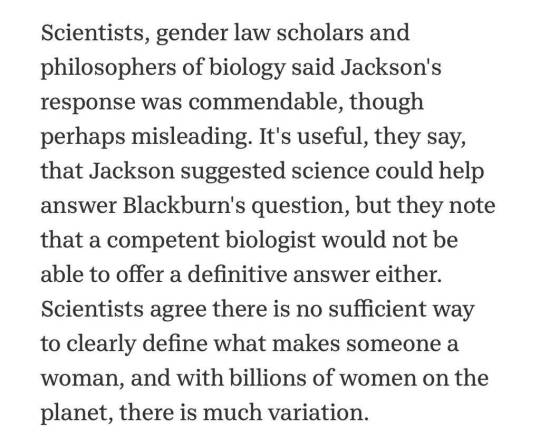
On 22 January 2019, Titania called for the Oscars to prioritise diversity.

On 12 June 2020, the Academy concurred.

On 30 January 2019, Titania accused Laurence Olivier of a hate crime for his performance as Othello.

On 9 October 2021, the University of Michigan concurred.
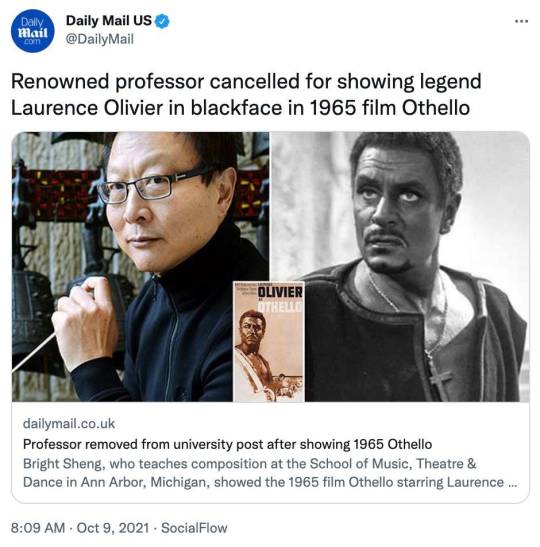
On 2 May 2020, Titania criticised the NHS for appropriating the LGBTQ rainbow flag.

On 6 May 2020, Forbes Magazine concurred.

On 6 June 2019, Titania demanded an option on social media to mute white males.

On 14 July 2020, Instagram concurred.

On 12 September 2019, Titania argued that scientists cannot possibly know whether ancient skeletons are male or female.
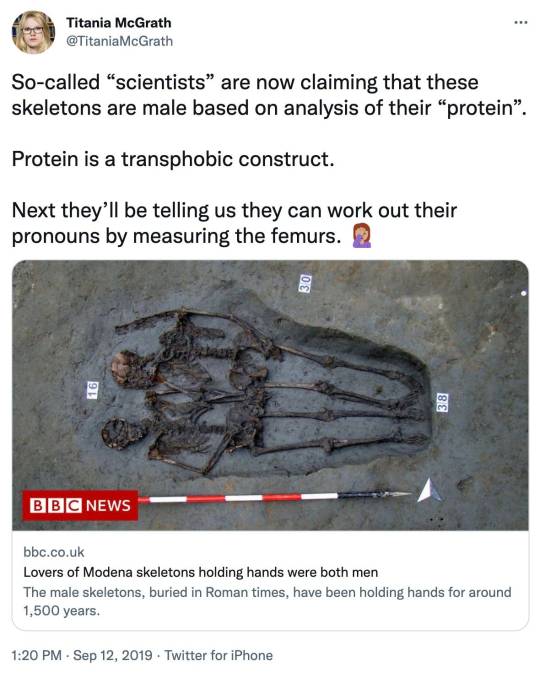
On 18 July 2022, gender activists concurred.
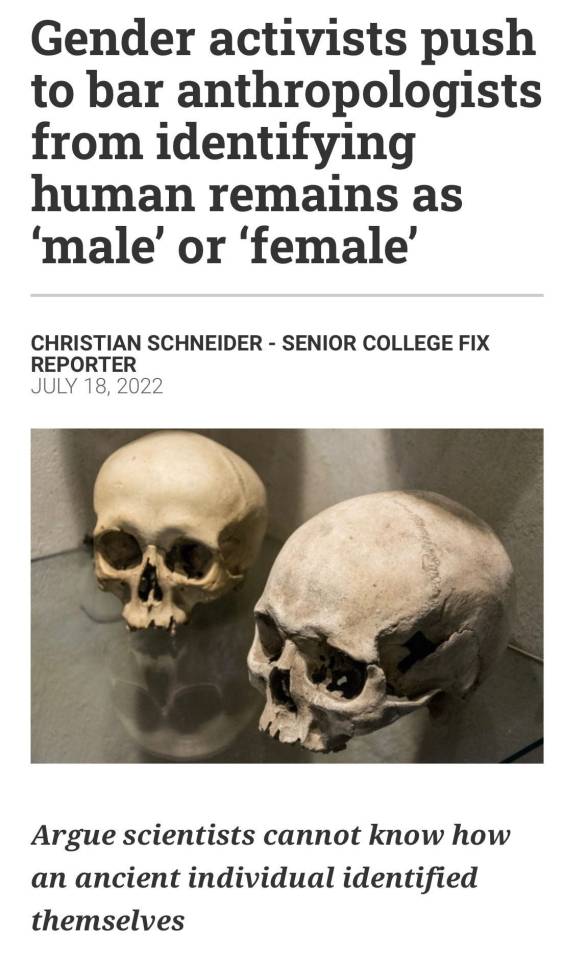
Titania McGrath’s Woke: A Guide to Social Justice is available to buy here. It’s also available on audio book and Kindle.
==
This ideology has become so deranged that it's not possible not parody it anymore. Anything you propose in jest today, they'll take up in sincerity tomorrow. Which shows how performative, directionless and unserious they are.
The Civil Rights and Gay Rights movements had specific aims: eliminate segregation, ensure all laws are race-neutral, that opportunities and resources are available regardless of race, decriminalization of homosexuality, recognition of same-sex partnerships the same as opposite-sex partnerships, including marriage. They were specific, measurable and could be ticked off as they fell.
Woke idiots have no damn clue what they're after. And all they can show us is the stupidest, most petty, most insane non-issues that telegraph to the world they have no real problems to complain about. Elimination of all skyscrapers? A lawsuit over who owns the rainbow? (Fundamentalist Xians would like to get in on that.)
They're just making this crap up as they go along, fighting for who can be the most offended and screaming about their imaginary hurt feelings to garner attention and control.
Why did we ever pay attention to this lunatics?
#Andrew Doyle#Titania McGrath#parody#feminism#intersectional feminism#parody account#LOL#funny#woke#Poe's law#wokeness#cult of woke#wokeism#wokeness as religion#victimhood#victimhood culture#religion is a mental illness
15 notes
·
View notes